These amazingly tasty oatmeal scones are made with flour, oats, honey and butter. They're utterly delicious.
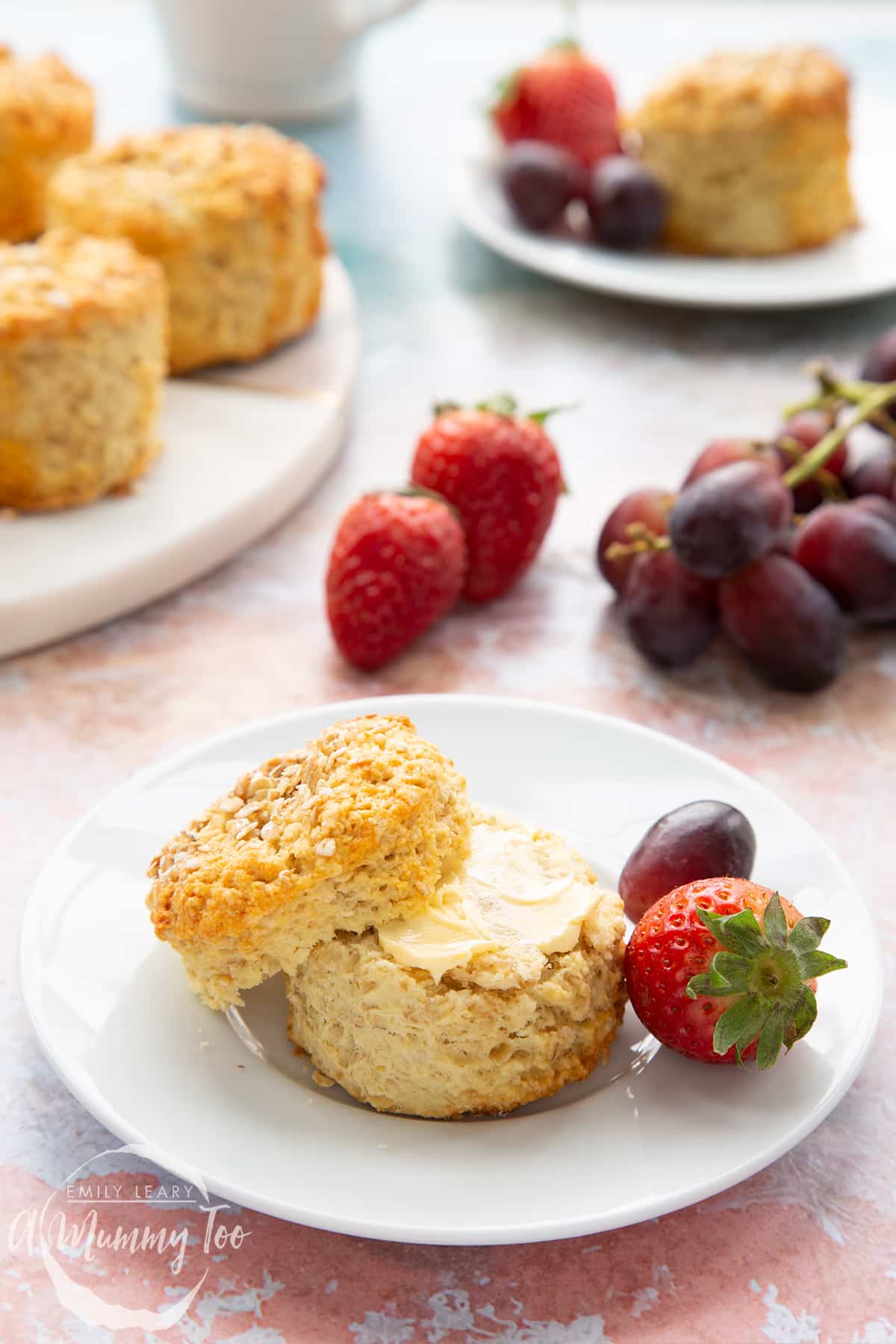
The recipe is super easy, and I've put together lots of step-by-step pics to help you get perfect results, every time.
To start, you'll mix flour, sugar, oats and bicarbonate of soda in a bowl, then use your fingers to rub in cold, cubed butter to produce a light crumb. Finally, you'll add milk and cut it through the crumb with a rounded cutlery knife until it starts together.
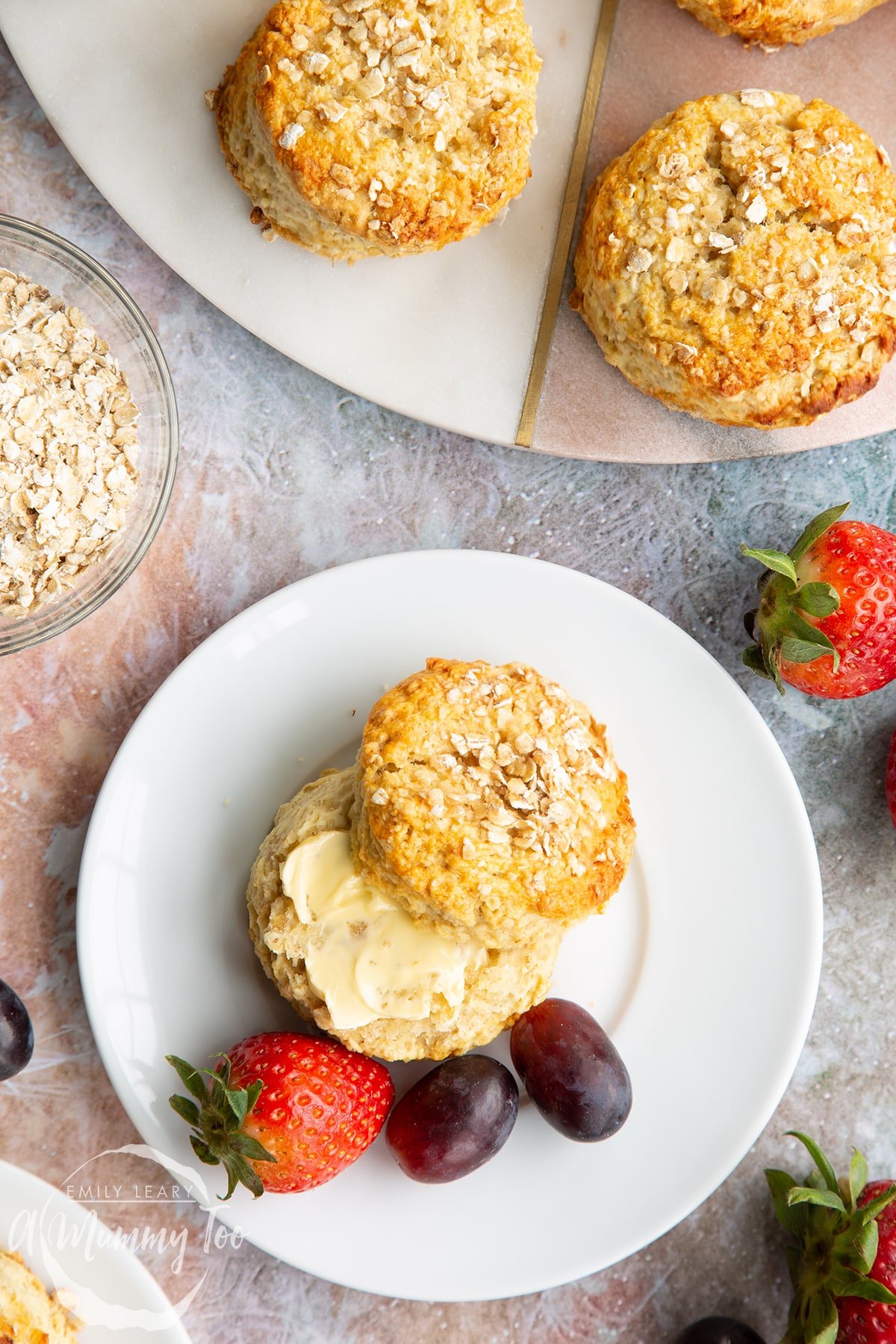
The trick to a light scone is to handle the dough as minimally as possible, so you'll turn the dough out onto a clean surface and knead just enough to bring together into a ball - it doesn't need to perfectly smooth. Next, you'll press the dough lightly with your fingers (no rolling pin!) to flatten to about 2.5cm (1 inch) thick, then cut out your rounds.
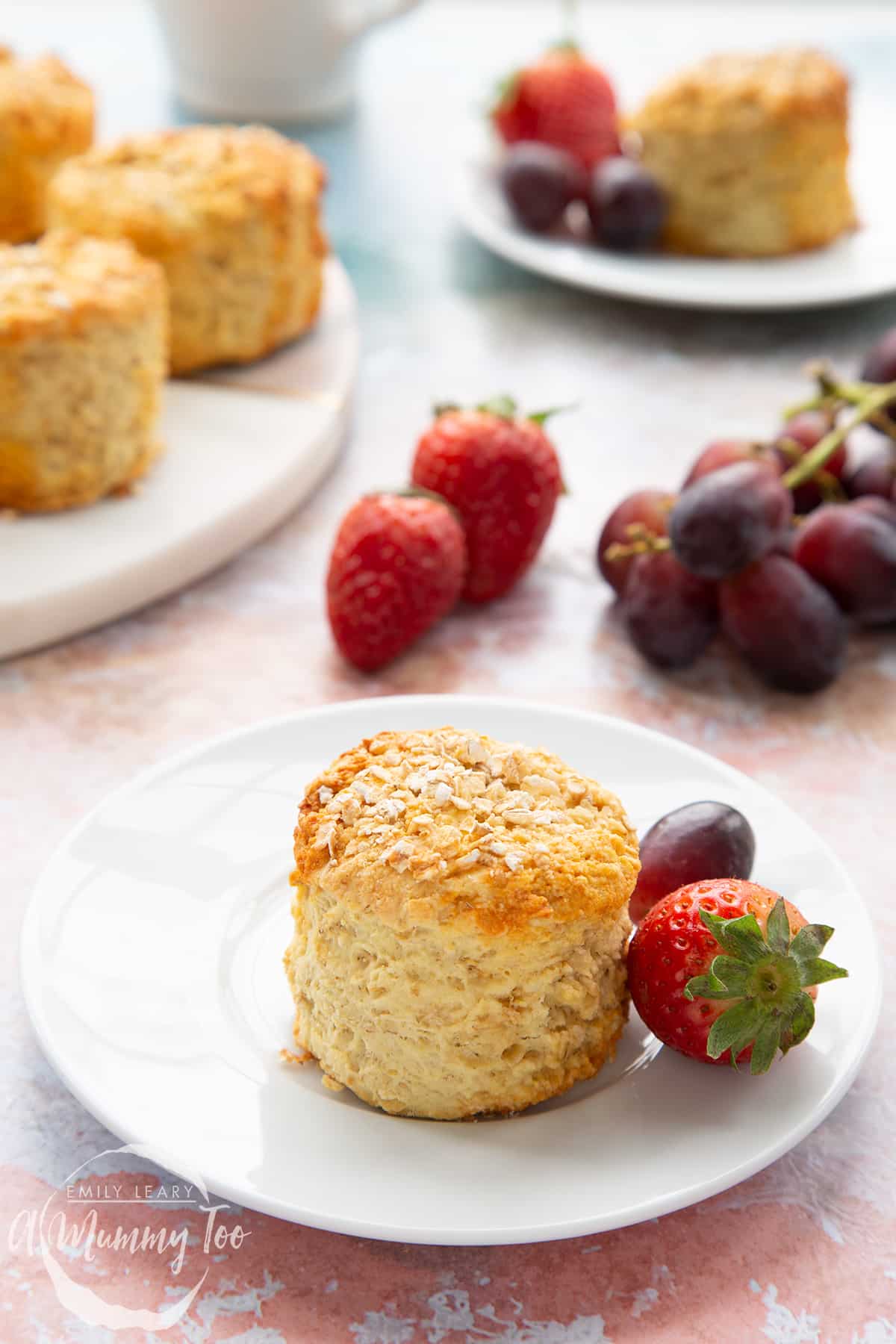
To bake, you'll transfer the rounds to a greased baking tray, brush with milk, scatter with oats, drizzle with honey and bake until puffed and golden. They're perfectly crisp on top and fluffy inside. Yum!
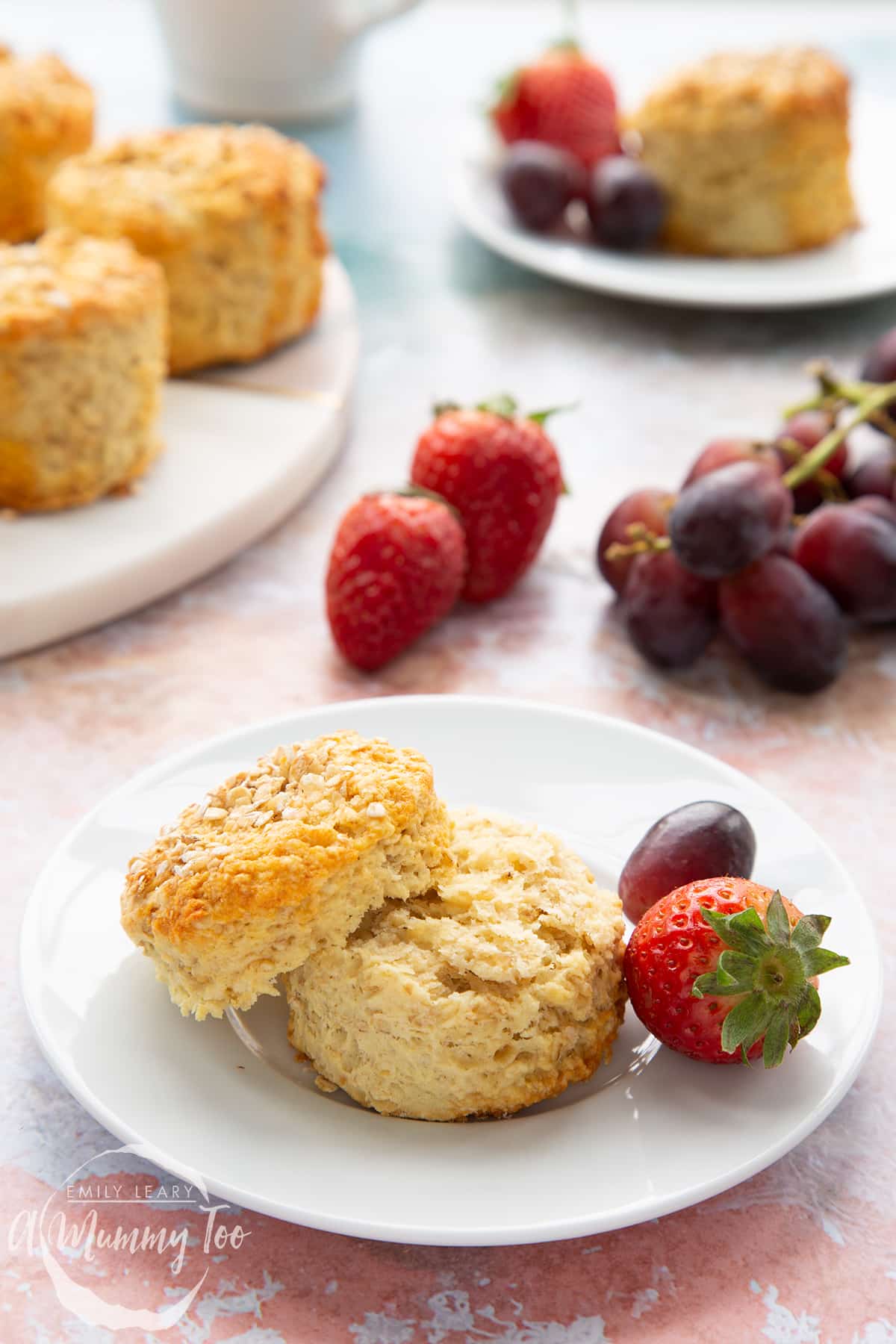
Here's the full recipe for my delicious oatmeal scones.
Ingredients
- 400 g (2⅔ cups) self-raising white flour (self rising flour) plus some for dusting
- 2 tbsp granulated white sugar
- ½ tsp bicarbonate of soda (baking soda)
- 100 g (1 cup + 2 tbsp) oats plus 1 tbsp for the top
- 100 g (7 tbsp) slightly salted butter
- 200 ml (½+⅓ cup) whole milk plus 1-2 tbsp to brush the tops
- 1 tbsp honey
Equipment
Instructions
Preheat the oven to 200C/390F (180C/355F fan).
Put the flour, sugar and bicarbonate of soda in a bowl.
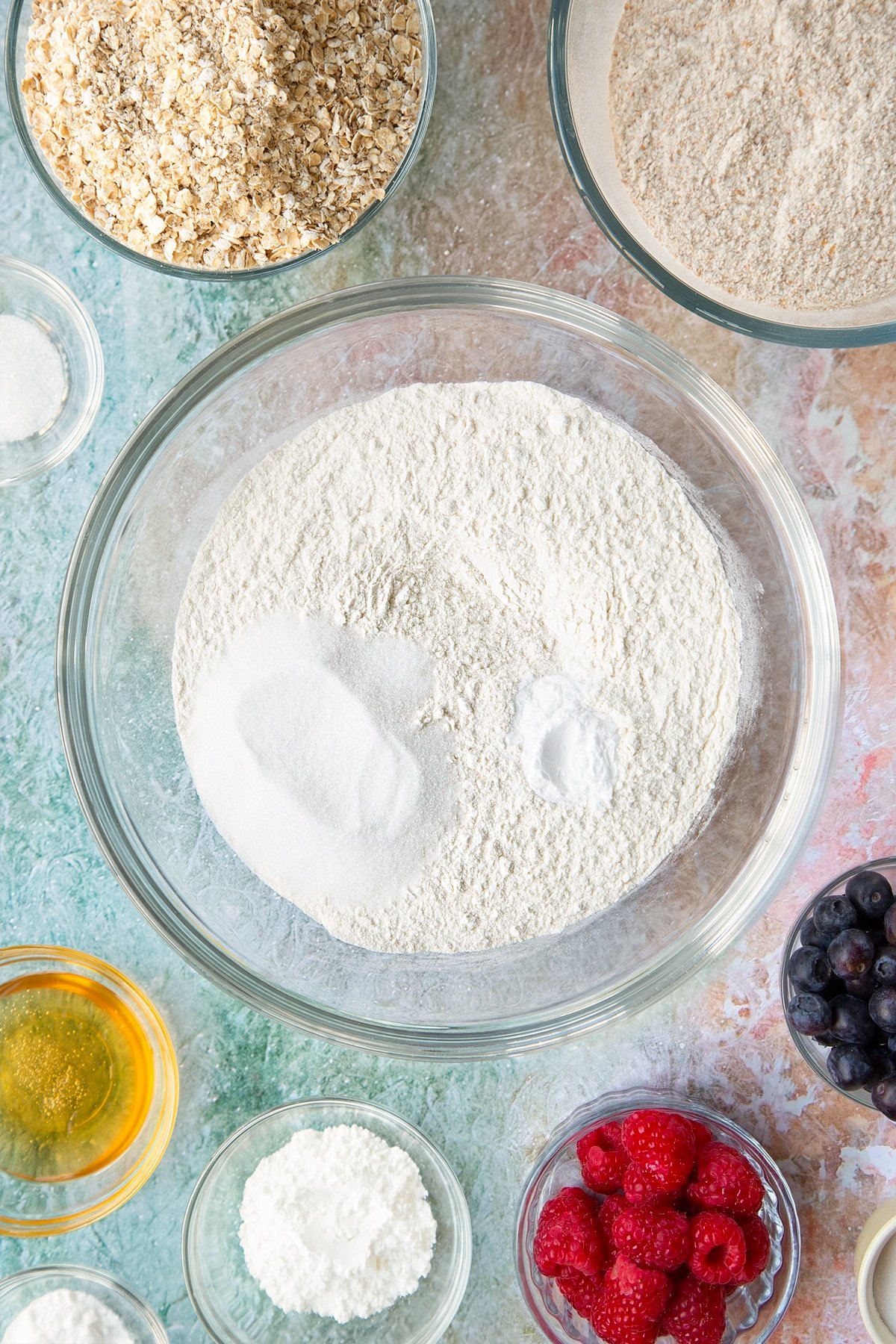
Whisk together to get evenly distributed.
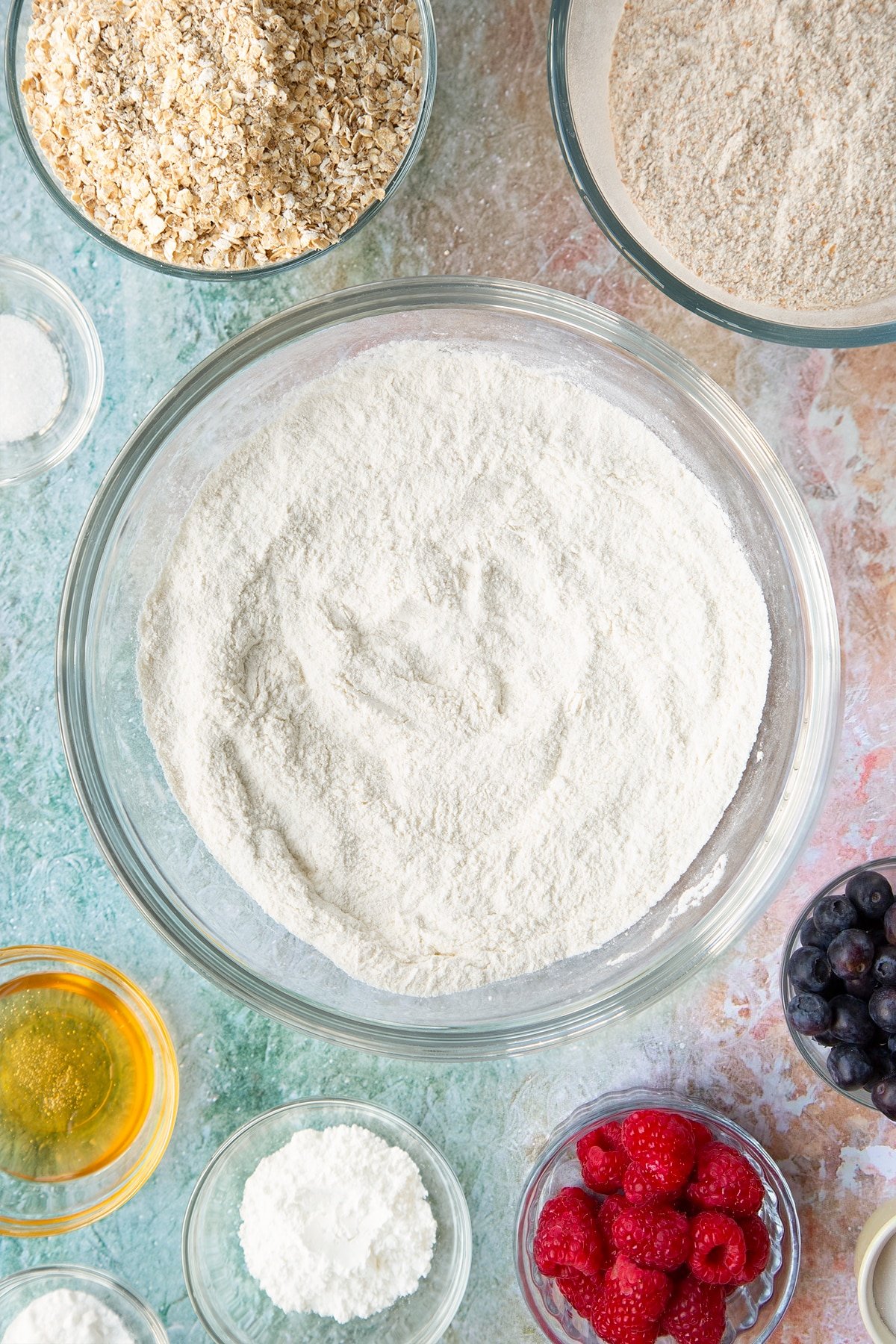
Add the oats.
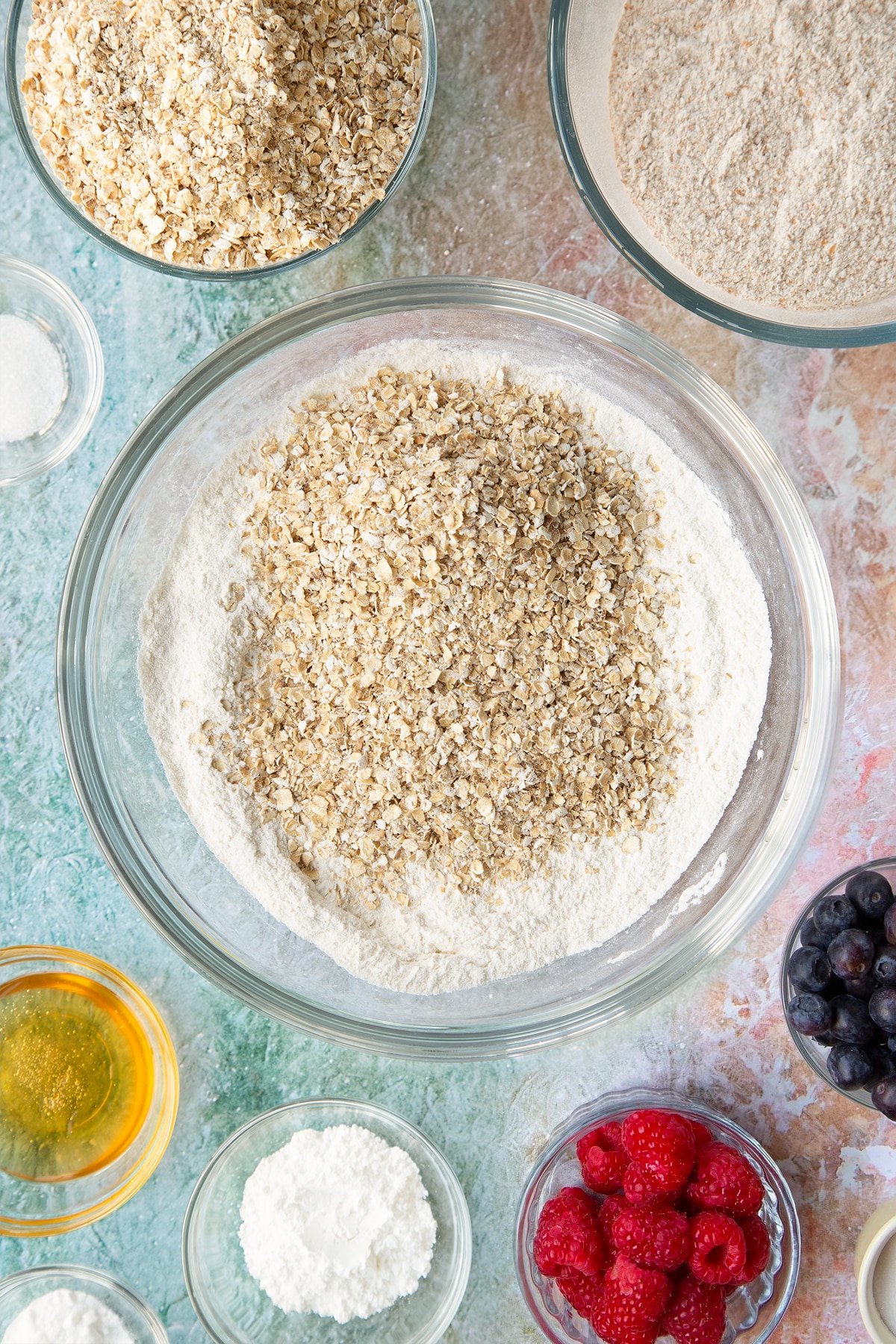
Whisk again.
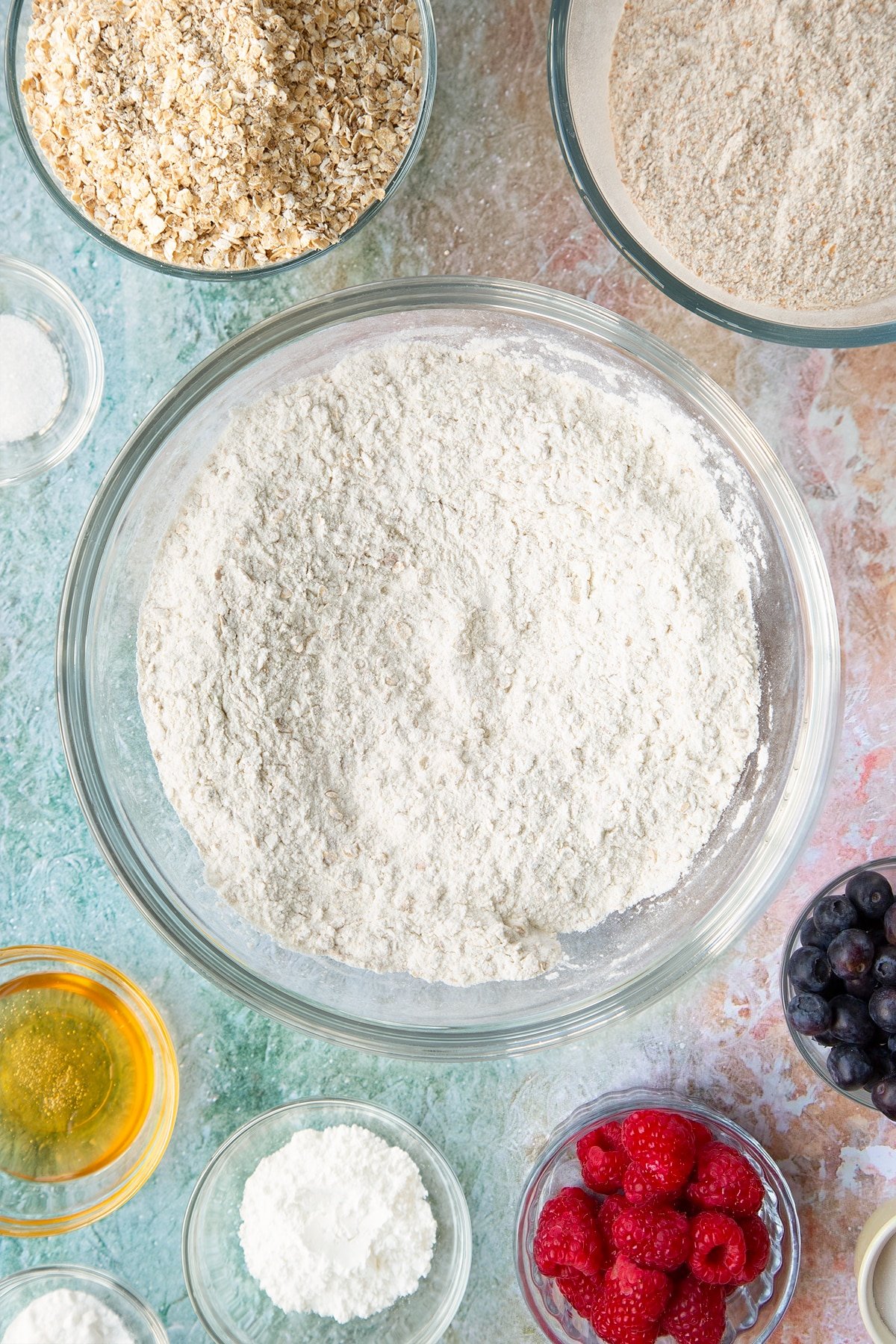
Add the butter.
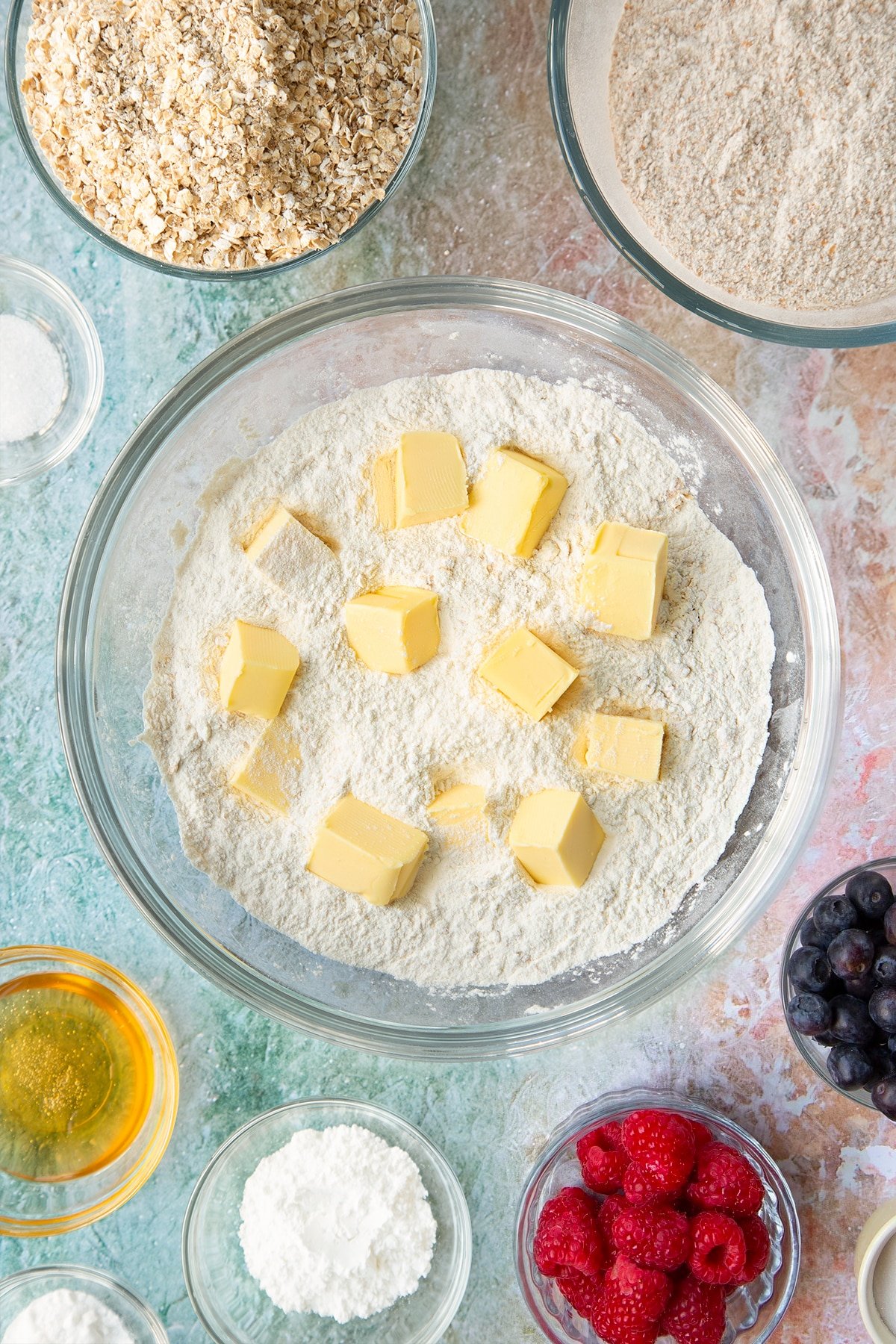
Rub together until you have an even crumb.
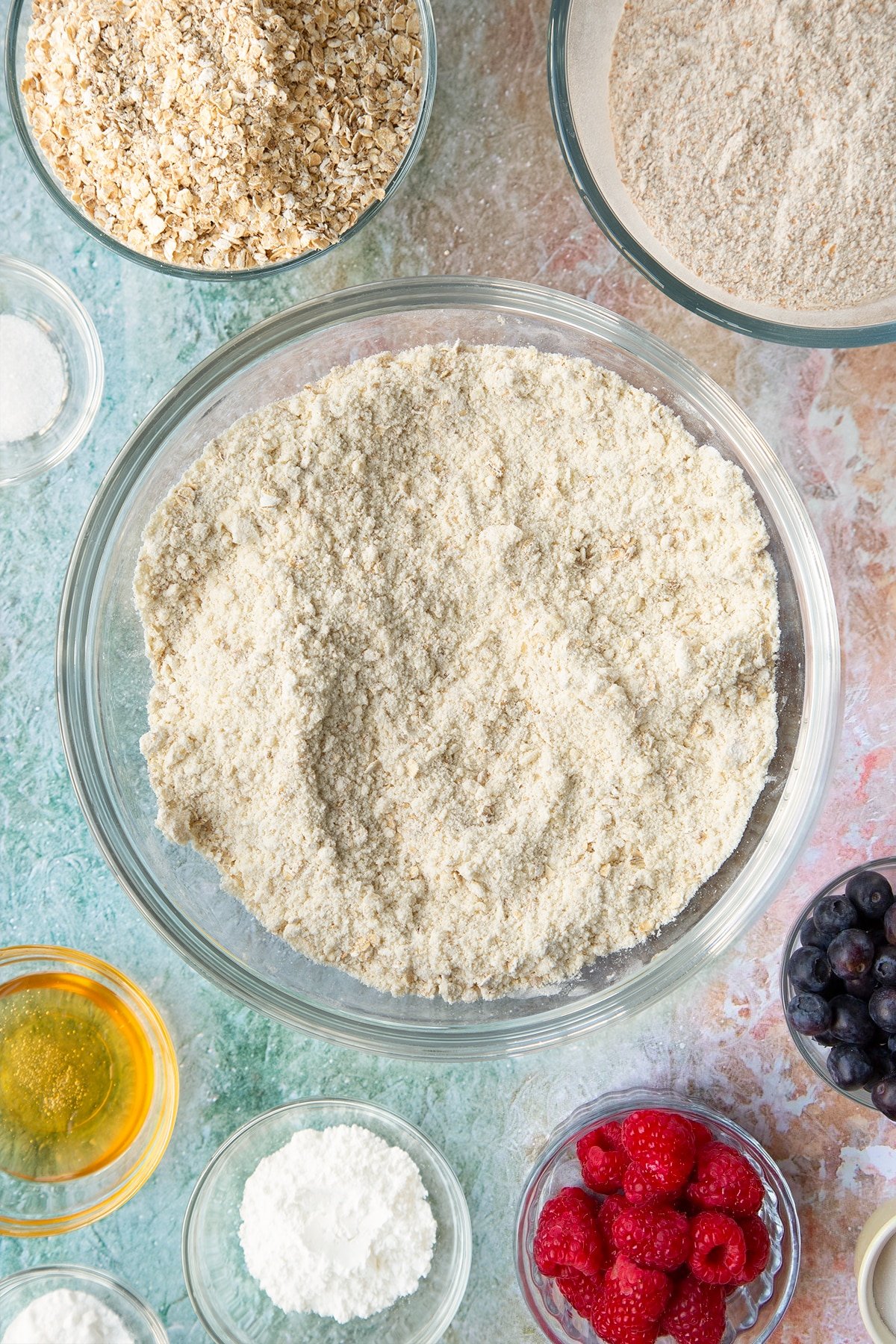
Add the milk.
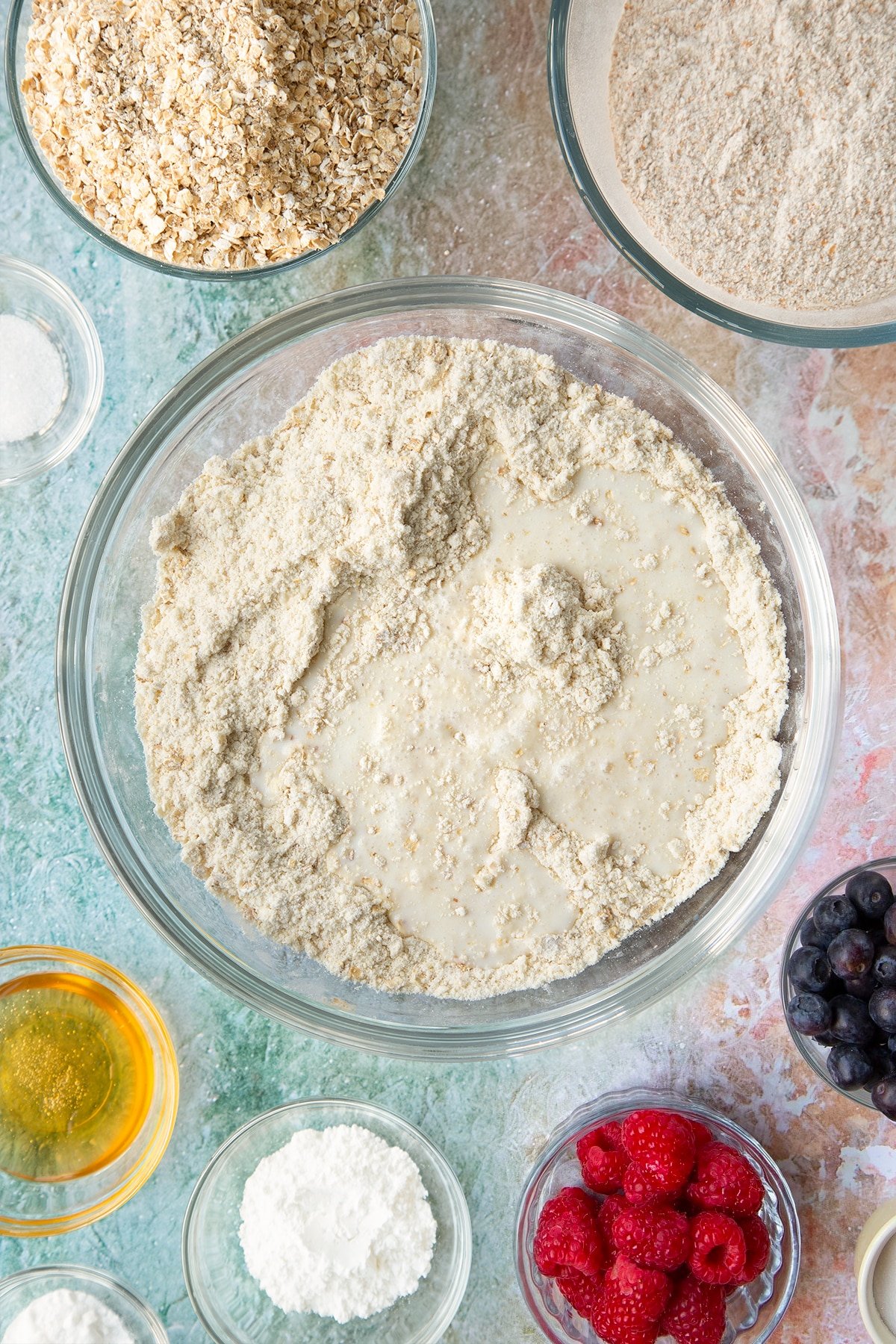
Mix with a rounded knife until it clumps.
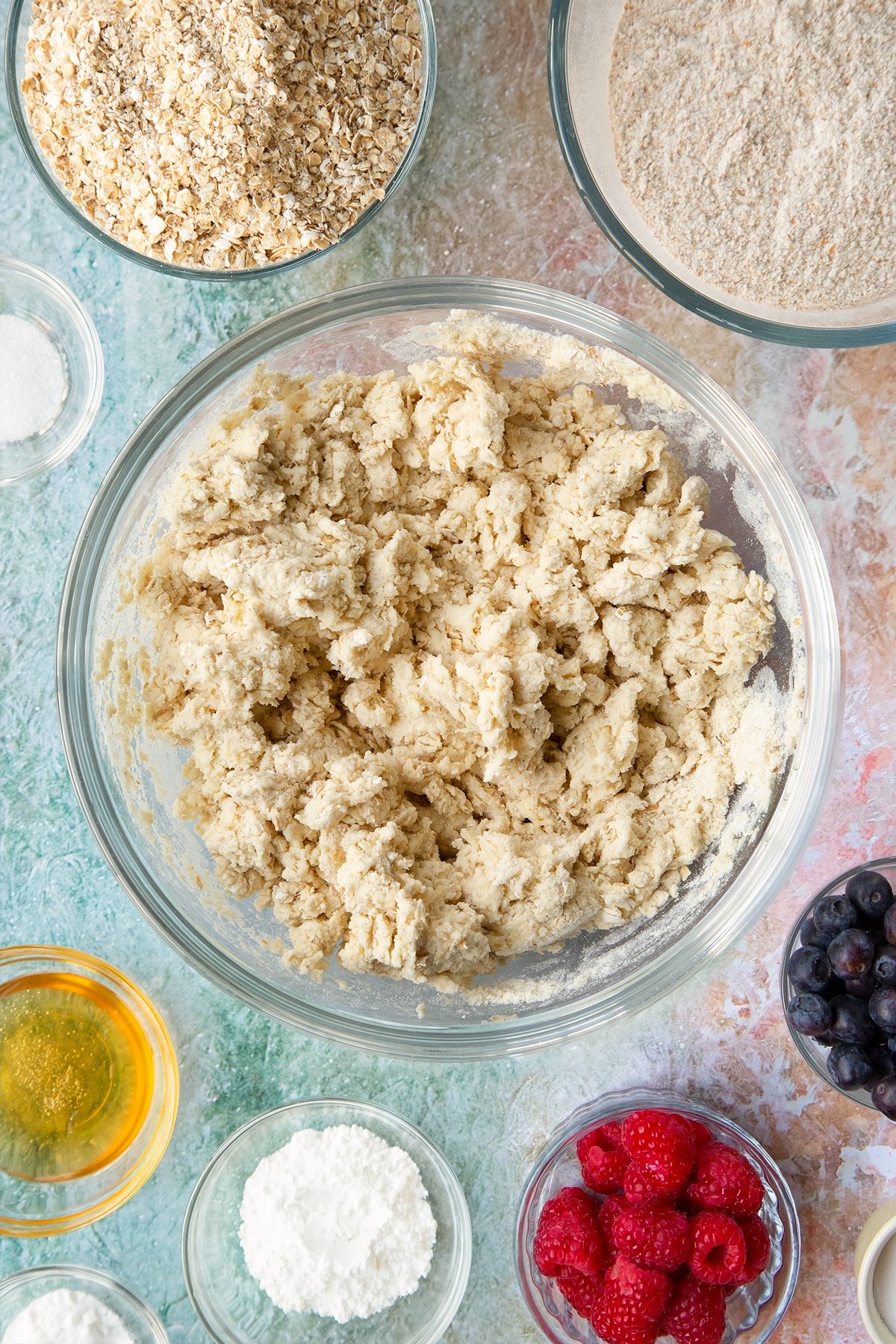
Tip onto your countertop. Knead gently into a ball, handling as little as possible - don't worry if there are some cracks.
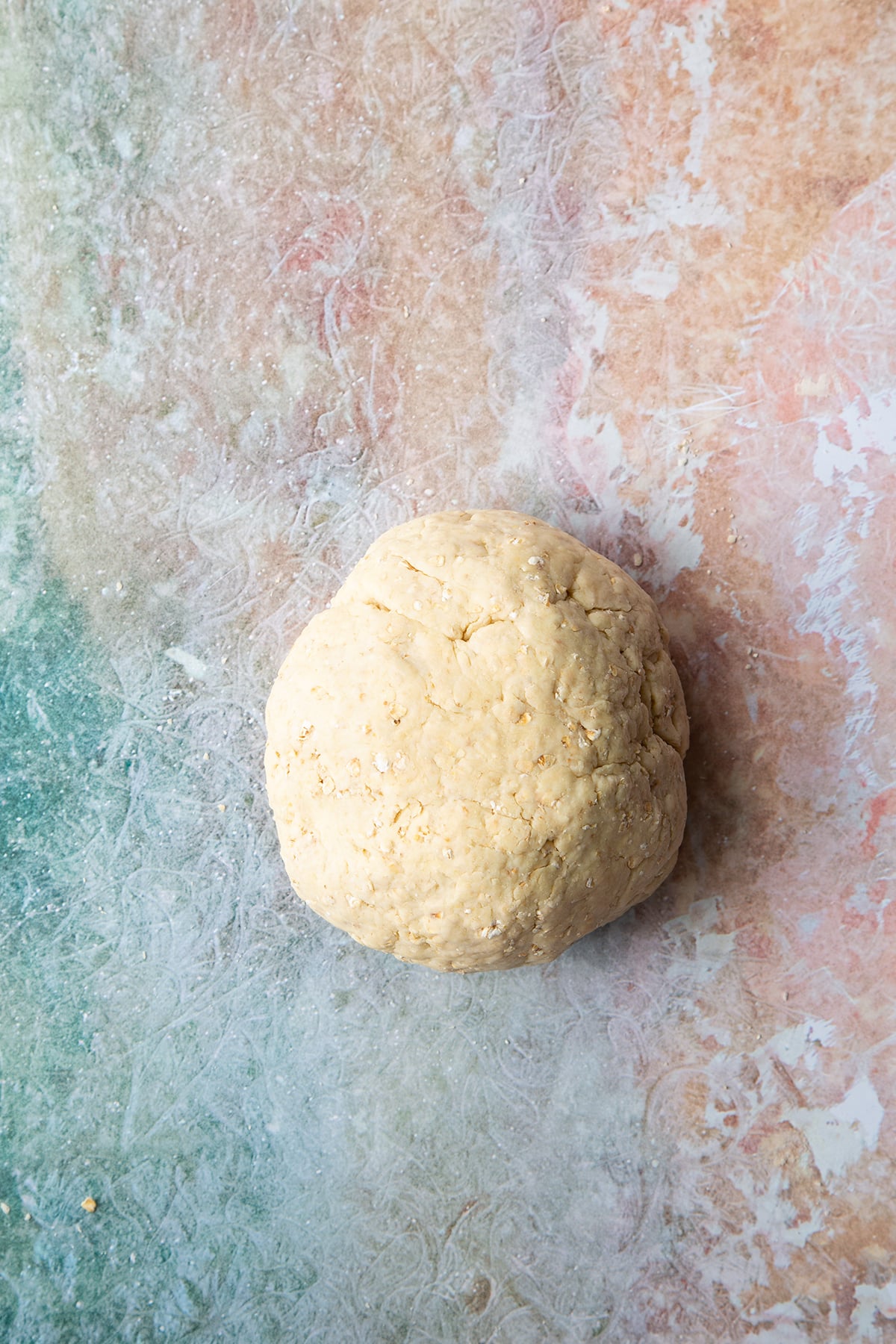
Flatten to about 2.5cm (1 inch) thick. Use your hands not a rolling pin so that you don’t compress the dough.
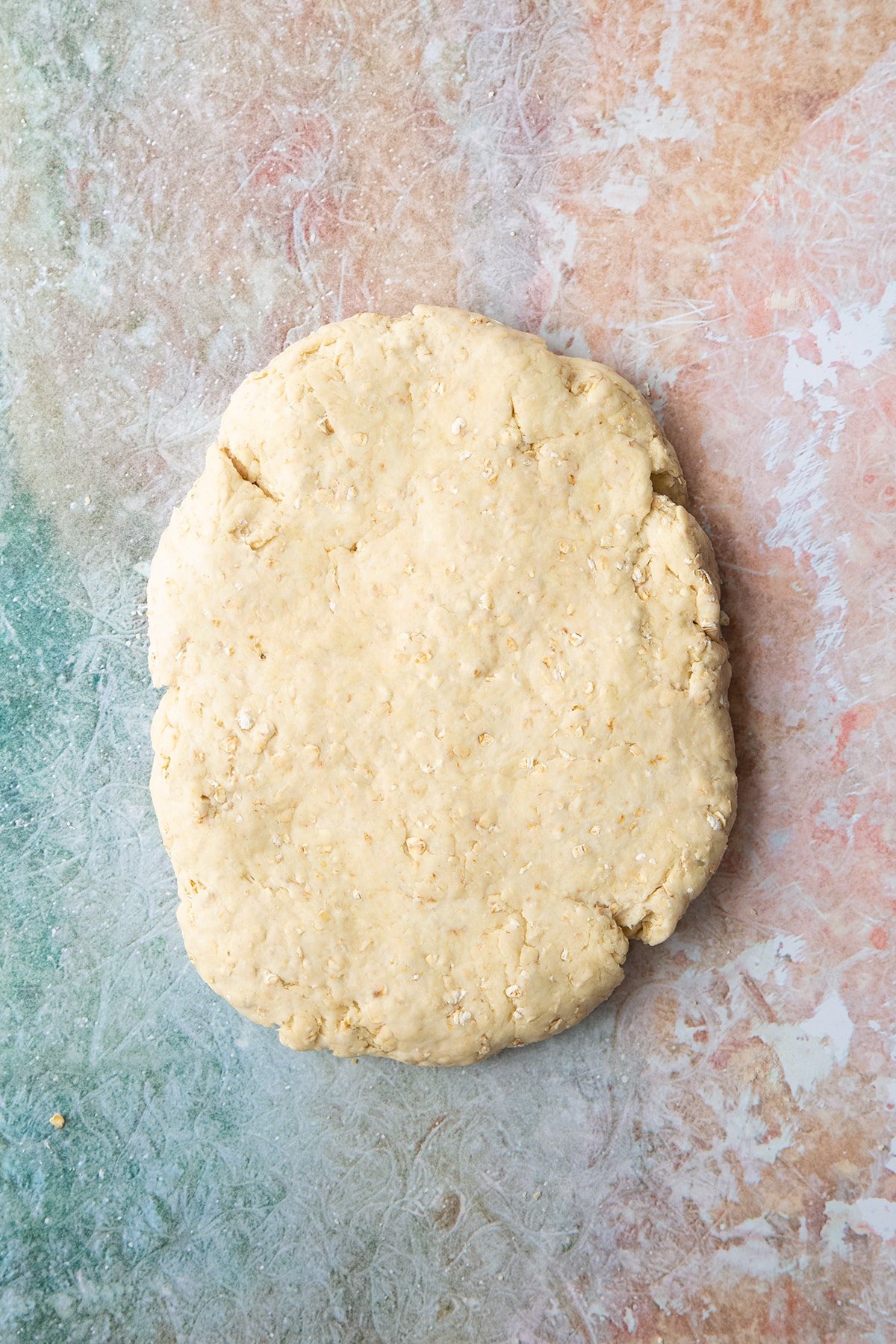
Cut out 6cm (2.5 inch) rounds. You'll need to gather and reshape the offcuts at least once to use it all up - handle the dough as little as possible in doing so. You should get 10-12 rounds in total, depending on how thickly or thinly you pressed your dough.
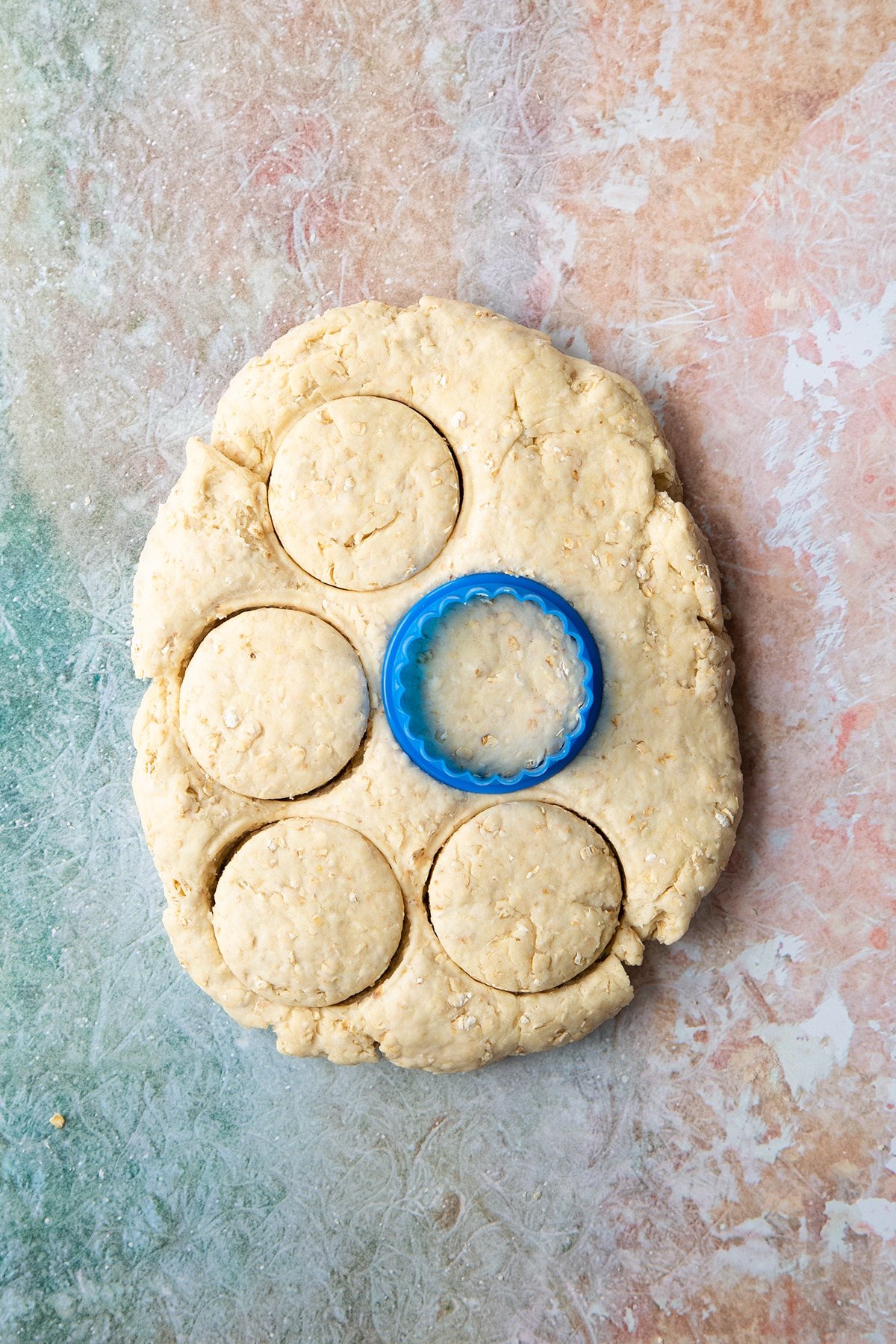
Transfer the dough rounds to a greased baking tray.
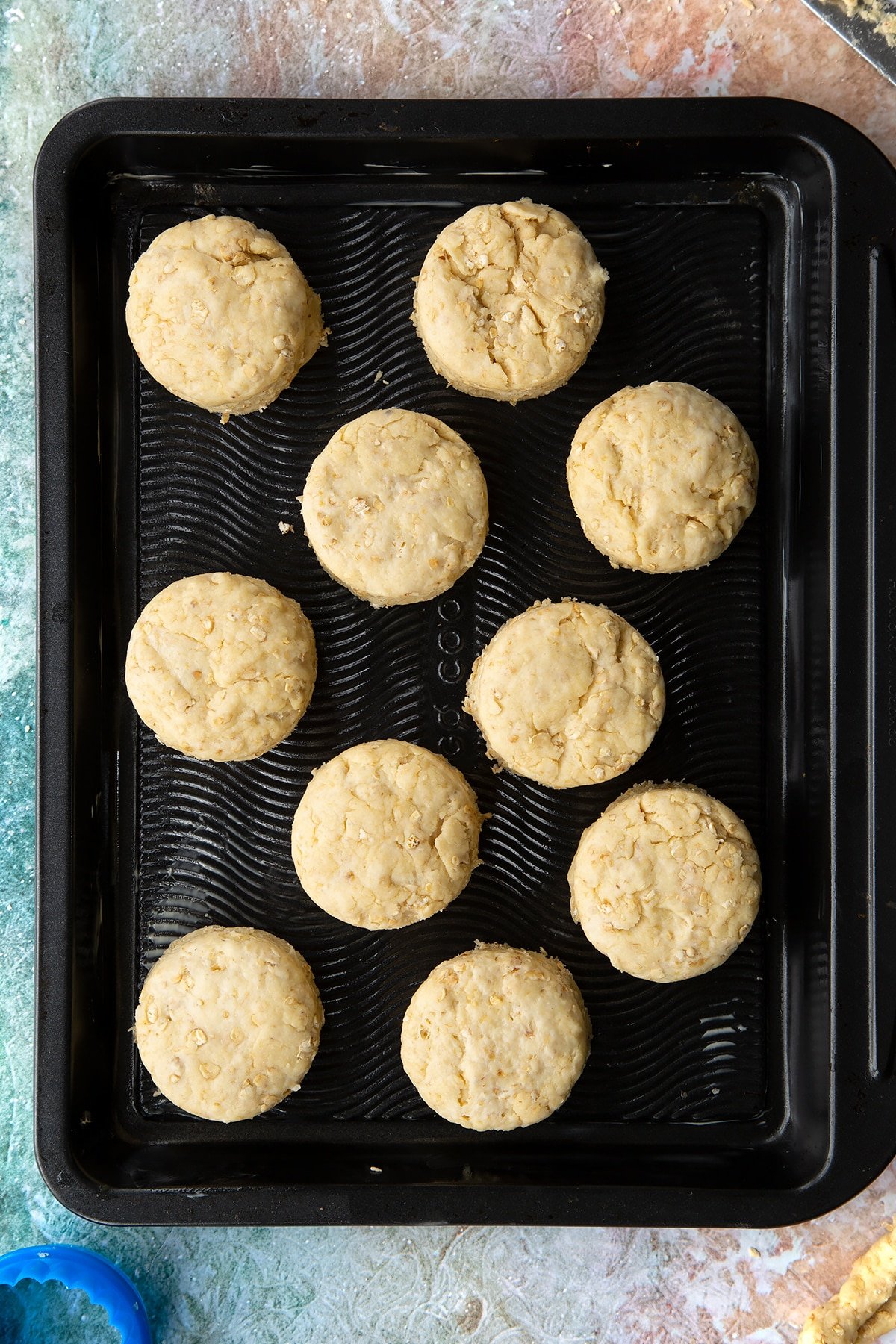
Brush the tops with plant milk.
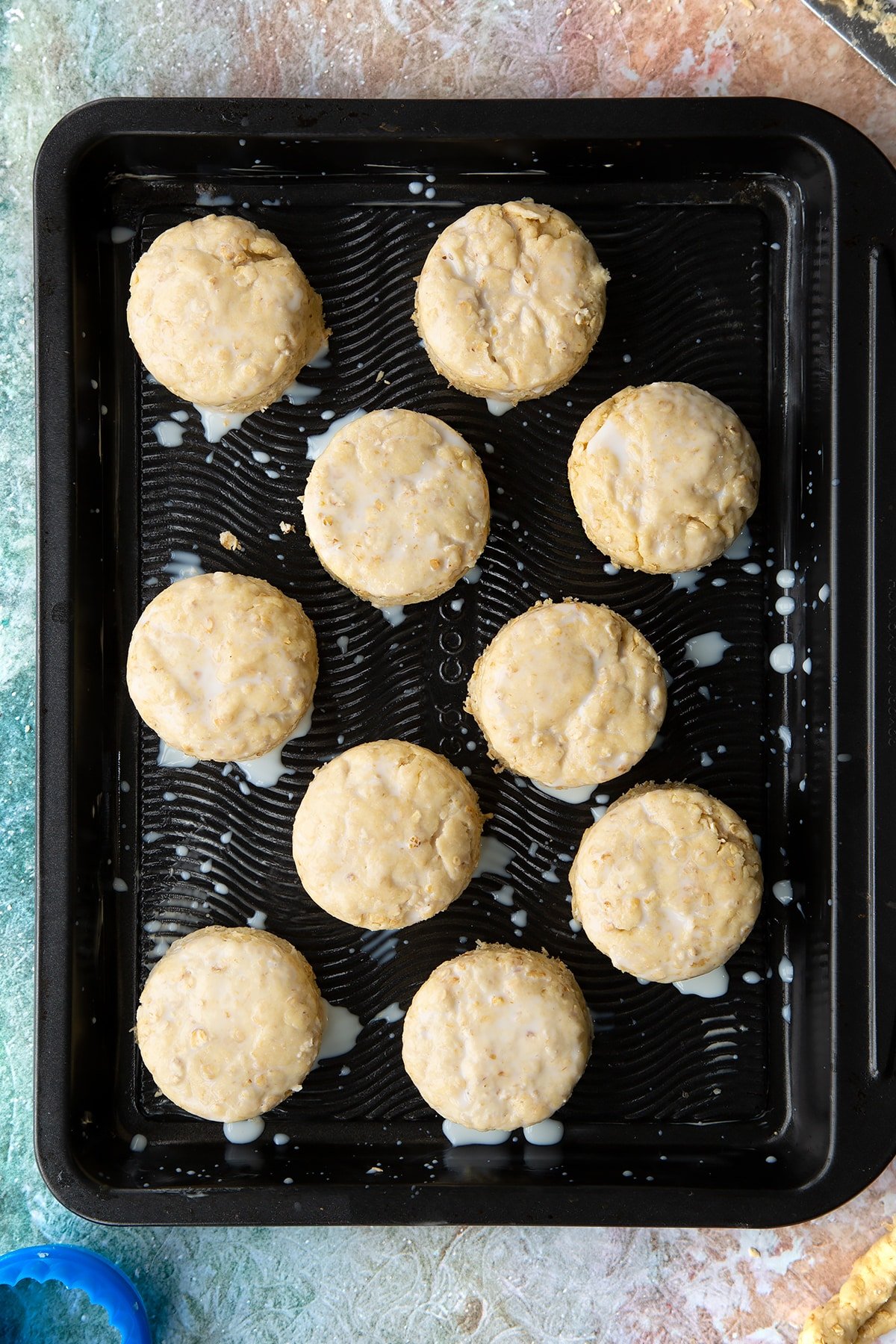
Scatter with oats.
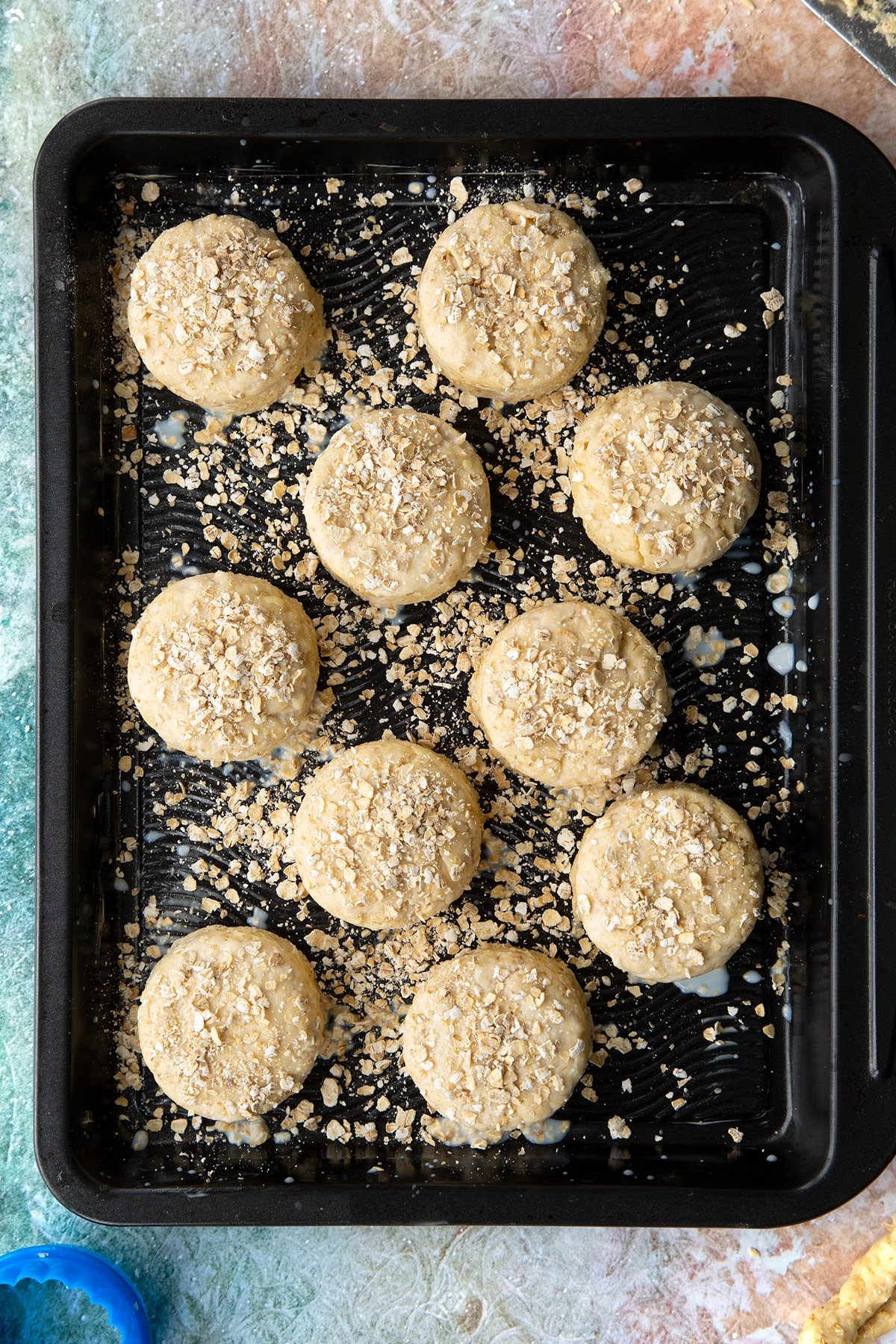
Drizzle with honey.
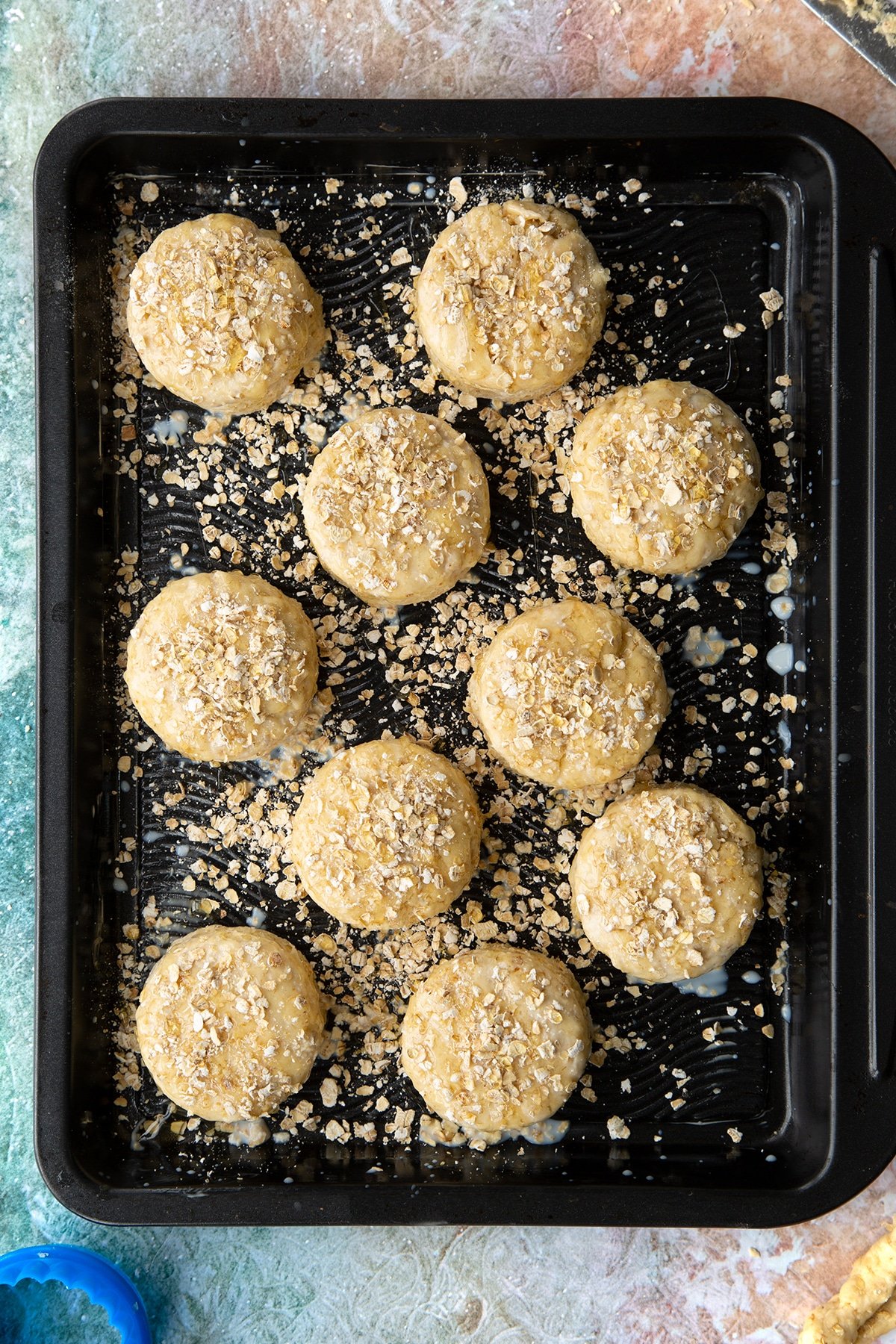
Bake for 12-14 minutes until the scones have grown tall, golden and are cooked through.
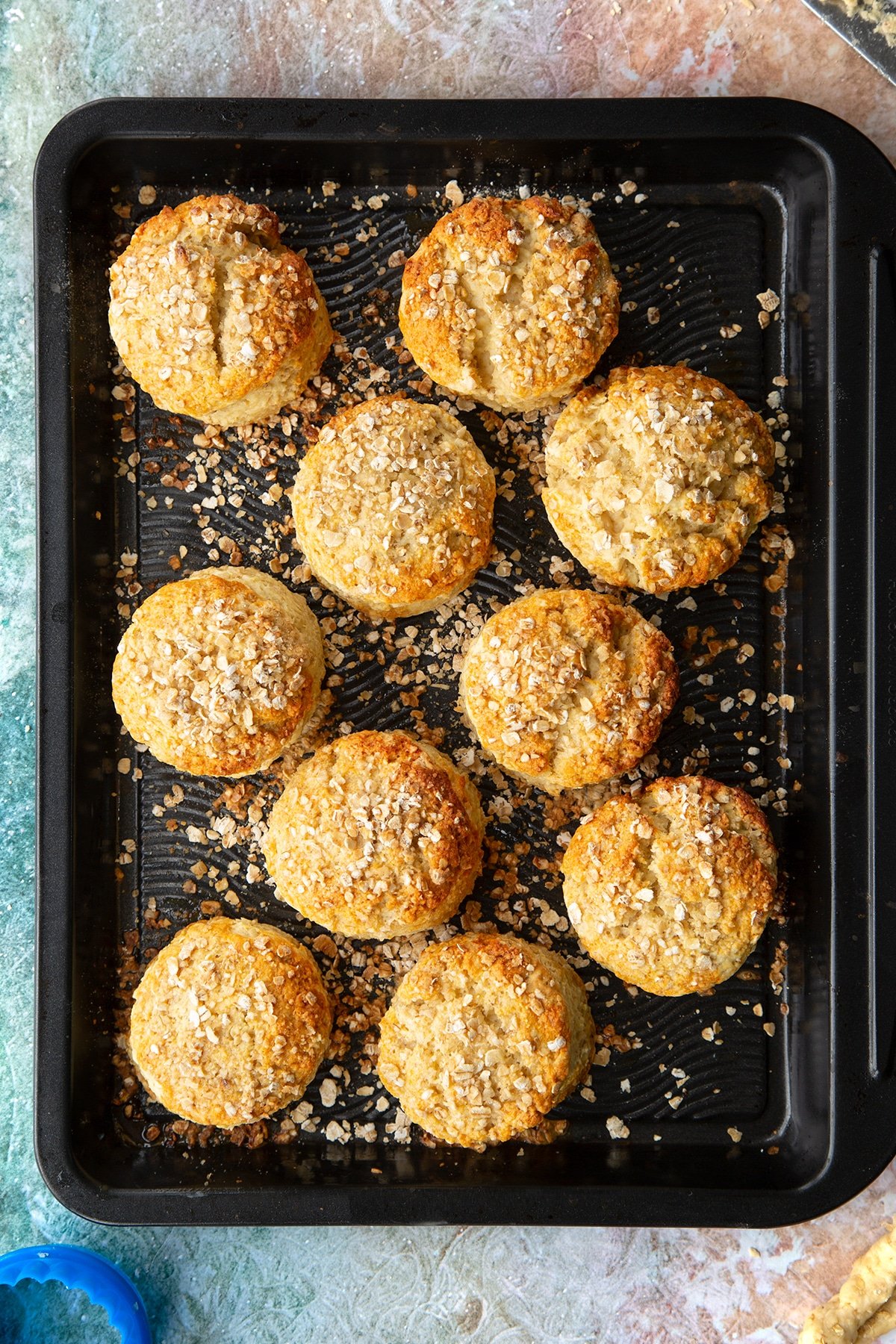
Allow to cool before serving.
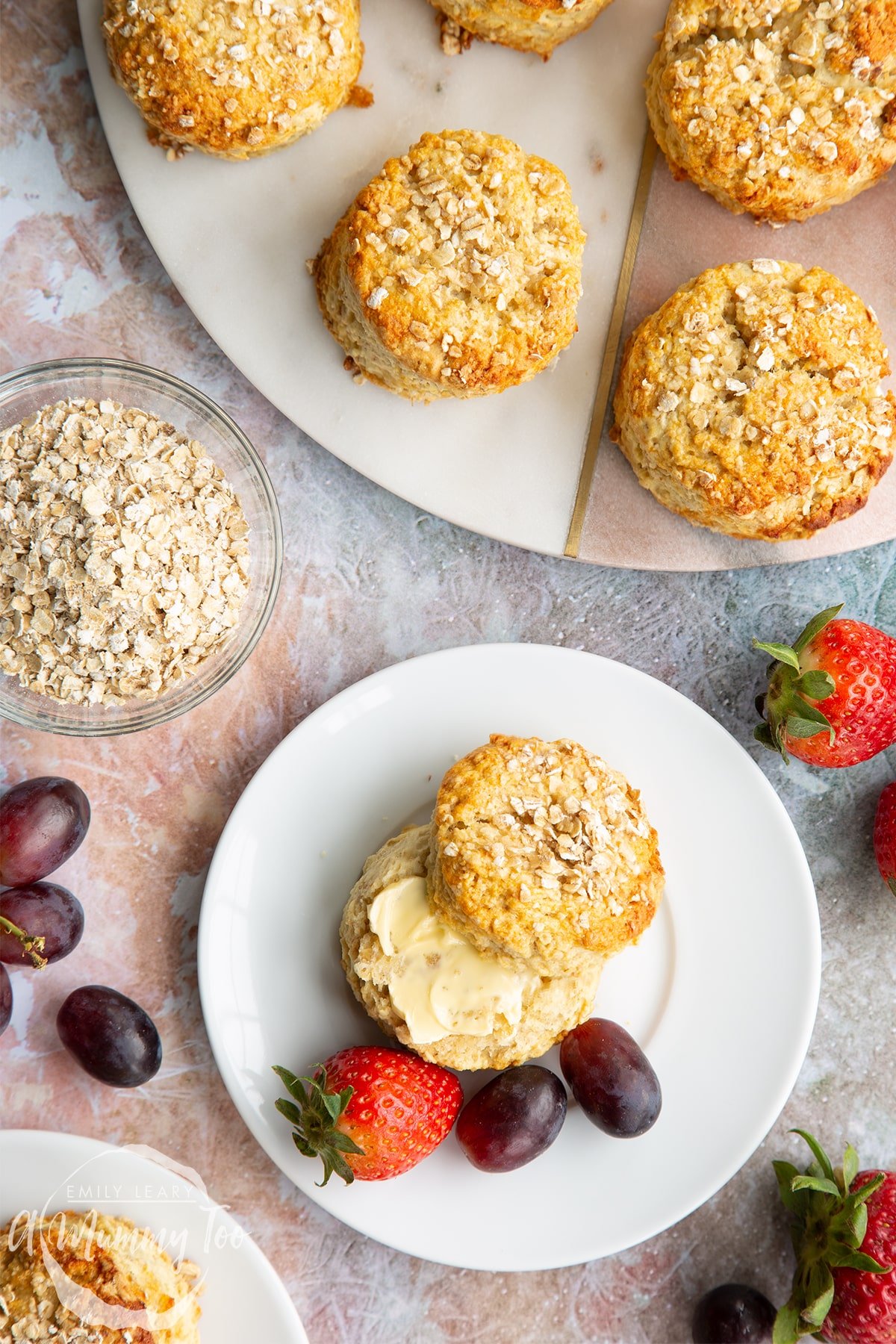
Pointers, tricks and troubleshooting tips for the perfect oatmeal scones
Is it easy to make oatmeal scones?
Yes! This scone recipe is super simple, and with just using a few ingredients you likely have in the cupboard and fridge you can make perfect scones in no time. Nothing beats a freshly baked scone, and the added oats in this recipe give a lovely flavour and texture too.
Serve still warm spread simply with butter and fresh fruit or go all out with clotted cream and jam, yum!
Will I need any special equipment for these oatmeal scones?
Everything you need to make these scones should be easy to find in any home baker's kitchen. The usual kit of weighing scales, measuring spoons, and a mixing bowl is needed.
I use a simple hand whisk to mix the flour, sugar, bicarb, and oats together as I find it helps to distribute everything evenly, but you can just use a wooden spoon if you like.
When it comes to mixing in the milk use a cutlery knife to cut the milk into the mixture - this helps distribute everything evenly while not overworking the dough.
You'll also need a cookie cutter and baking sheet. There is a full list of suggested equipment on the recipe card below.
Is this oatmeal scone recipe suitable for vegetarians?
This oatmeal scone recipe is vegetarian as it contains no meat, poultry or fish products.
It's always a good idea to double-check all of your ingredient labels to make sure that they are suitable for vegetarians. Don't forget to also check anything extra you intend to serve the scones with.
Is this oatmeal scone recipe suitable for vegans?
This oatmeal scone recipe contains honey, butter, and dairy milk so would not be suitable for vegans if the ingredients are followed to the letter. However, these ingredients are all easy to switch out for vegan plant-based alternatives if you want to try and make these oatmeal scones vegan-friendly.
In place of the butter, try a plant-based alternative that is high in fat - around 80% is good, as this is similar to the fat content in dairy butter so it behaves in a similar way.
The milk can be replaced with your favourite plant milk. A great swap for this recipe would be to use oat milk as it will go well with the oatmeal flavour. Oat milk is also ever so slightly acidic, which will help activate the bicarbonate of soda and make your scones rise beautifully.
The honey can be left out or replaced with agave or maple syrup. Remember both bring a bit more sweetness and a distinct flavour compared with honey, so use sparingly.
Or if it's easier for you, just try out my vegan scone recipe.
Double-check all of your ingredient labels to make sure that they are suitable for vegans. Don't forget to also check anything extra you intend to serve the oatmeal scones with.
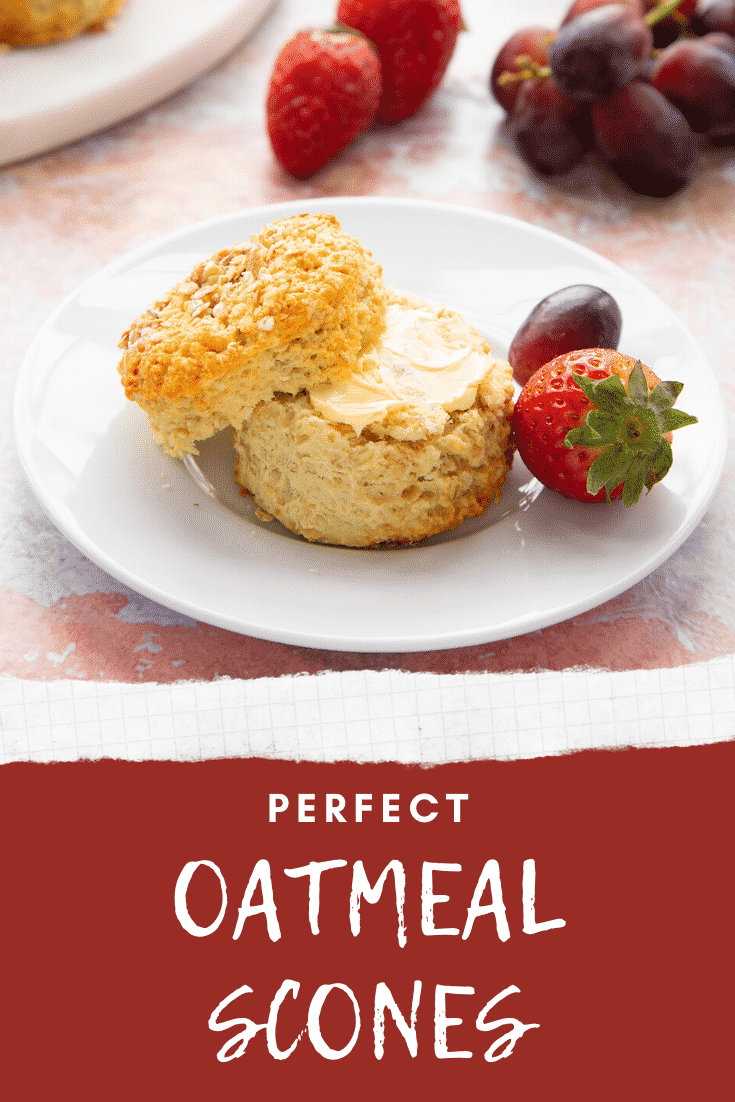
Is this oatmeal scone recipe gluten-free?
No, this oatmeal scone recipe is not gluten-free. The wheat flour I've used contains gluten and the oats may be cross-contaminated in production.
I haven't tested this recipe with gluten-free alternatives yet but you could give it a go. Since this a quick bread that doesn't rely on gluten development, it should work well.
Use a good quality brand of gluten-free self-raising flour, and check the oats you are using are also gluten-free. Oats themselves are naturally gluten-free but they are often processed in factories that also handle wheat products, so get oats that are labeled gluten-free as these won't have been in contact with wheat products. Visit Coeliac UK for more information about oats.
Double-check all of your ingredient labels to make sure that they are gluten-free. Don't forget to also check anything extra you intend to serve your scones with.
Is this oatmeal scone recipe keto-friendly?
Each oatmeal scone contains an estimated 35g of carbohydrates so these scones are not keto friendly.
Is this oatmeal scone recipe healthy?
Like most bread products, these oatmeal scones can be enjoyed as part of a balanced, healthy diet. Of course, what you serve them with will affect the overall nutritional values. For example, a tablespoon of jam contains about 2 teaspoons of sugar.
If you wanted to make these into slightly smaller portions, you can simply use a slightly smaller cookie cutter. Smaller scones may bake faster, and you will make more from the same amount of dough, so consider freezing some if you have too many!
On the recipe card at the bottom of this page you'll find some more detailed nutritional information. All the figures are estimates based on publicly avaible data.
Is this oatmeal scone recipe safe to eat while pregnant?
There's nothing in these scones that would usually pose a risk if eaten during pregnancy.
Make sure all the ingredients are in good condition and this meal is prepared safely and hygienically.
A Mummy Too does not offer medical advice. Please seek help from a medical professional if you need further information or have any concerns.
Are oatmeal scones suitable for babies and toddlers?
These scones contain sugar and honey, both of which the NHS recommends not giving to babies and young children. The sugar and honey can be left out if you want to try and make these scones for little ones to enjoy too.
Always give food at an appropriate size and shape for your baby or child. Cut small, round foods, like grapes and cherry tomatoes, into small pieces.
Always keep babies supported upright while eating and supervise your baby when they’re eating in case they start to choke.
A Mummy Too does not give medical advice. If you have any questions or concerns please speak to a health professional.
The NHS has some fantastic resources on their website advising what to feed babies and young children.
What goes well with these oatmeal scones?
These oatmeal scones are perfect for a grab and go breakfast or a leisurely afternoon tea.
Simply spread with butter and serve with fresh fruit, or go full cream tea with clotted cream and jam. Whether with fresh fruit or with clotted cream and jam, these scones are excellent with a good cuppa. Enjoy!

Can I make these oatmeal scones without dairy?
If you need to avoid dairy, these scones can easily be made with dairy-free alternatives. If you can find a plant-based butter which has a high-fat content of around 80%, this will be best as it will behave in a similar way to butter. The milk can easily be replaced with oat milk (or any plant milk) to make these scones dairy-free.
I haven’t got honey can I use a different sugar syrup?
I haven't tested this recipe with alternative sugars.
For drizzling on top of the scones, golden syrup, maple syrup or agave syrup should work well. Keep in mind different syrups have different levels of sweetness, so you might want to use a bit less. Maple syrup also has a more distinct flavour, which will affect the overall taste of the scones, so make sure it's to your liking.
If you don't have any syrups, you could just leave it out, or sprinkle the tops with a little brown sugar for a crunchy, sweet top.
Can I add extras like fruit into these oatmeal scones?
Classic extras to add to scones include things like raisins or glacé cherries, which can both be easily included in this recipe if you like.
It's wise to stick with relatively dry ingredients like dried fruit, chocolate chips, or nuts, rather than try to add fresh fruit as this will reduce a lot of moisture, which can really affect your bake.
I'd recommend using up to 75g (2.6oz) of your chosen additions, chopping any larger pieces down to about the size of a raisin so that they distribute evenly throughout the scones. Add them after you've cut the milk through the dough, but just before you bring it together.
How should I store these oatmeal scones?
Make sure your scones are fully cooled before storing them so they don't go soggy. Once cooled, they are best kept in an airtight container somewhere cool and out of direct sunlight - in the cupboard or pantry will be fine.
How long do oatmeal scones keep?
Scones are best enjoyed as fresh as possible but these will keep for up to five days if properly stored in a sealed container somewhere cool and dry. They will become drier and more stale in texture as time goes on, so are best enjoyed within two days of baking.
Consider freezing some if you're not going to get through a whole batch promptly. There are more tips on freezing in the "Can I freeze oatmeal scones?" sections below.
Can I leave these oatmeal scones out on the counter?
If these scones are left out on the counter for prolonged periods of time they will dry out. To keep them fresh, allow them to cool and then immediately transfer to an airtight container.
Can I make these oatmeal scones ahead?
As with most bakes, scones are best enjoyed as fresh as possible, and these scones are really quick to make. If you do want to get ahead why not try freezing them as soon as they've cooled and then you can heat them up whenever you fancy fresh scones.
Can I keep these oatmeal scones in the refrigerator?
Scones, like most breads, don't usually fare well in the fridge. This is because as the bread cools to fridge temperatures, the starch re-crystallises, which makes the crumb stiff and gives a similar texture to stale bread.
For this reason, these oatmeal scones are best kept in an airtight container in the cupboard or pantry.
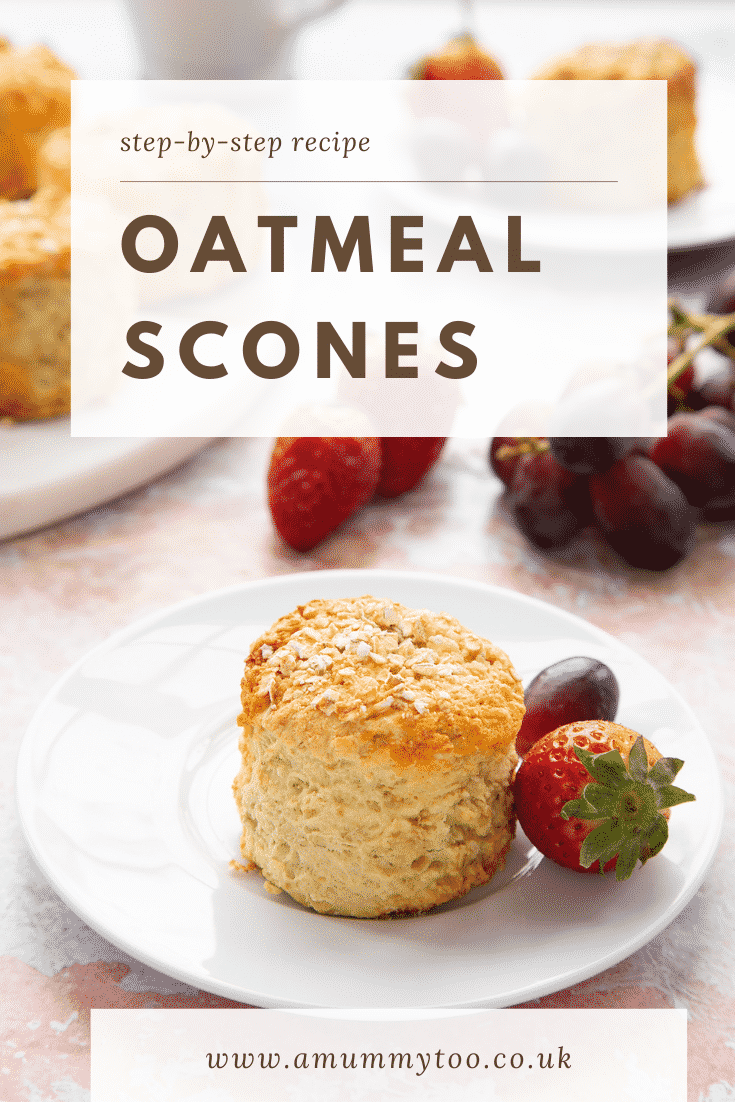
Can I freeze oatmeal scones?
These oatmeal scones freeze well and will keep in the freezer for up to three months. Make sure to freeze your scones as soon as they have fully cooled, this way they are being preserved at their freshest and will still taste great when you come to enjoy them later on.
If you have space in the freezer, simply pop the scones on a tray and freeze them overnight in a single layer, this stops them from sticking together. Once frozen, transfer into a suitably sized container or reusable freezer bag so that they take up less space. Make sure to squeeze out as much air as you can. Label the container with the date and type of scones so you can easily find them again.
What is the best way to defrost oatmeal scones?
When you're ready to enjoy your scones, you can either take them out of the freezer and allow them to thaw out on the side, or warm them through in the oven.
To thaw out on the side, put them on a plate on a piece of kitchen roll, and cover with a clean tea towel. They will take about 2 hours to defrost, then you can enjoy them cold or warm them through in the oven.
If you're in more of a rush to eat your scones, you can thaw them out in the oven at the same time as warming them up. Preheat the oven to 160C/320F (140C fan), wrap the scones in tin foil and place on a tray in the middle shelf in the oven. They will take 10-15 minutes to defrost, then unwrap them and pop them back in the oven for a further 5 minutes to warm through thoroughly.
Once thawed, don't refreeze your scones and consume within 24 hours.
What is the best way to reheat oatmeal scones?
The best way to reheat scones is in a low oven. Preheat to 160C/320F (140C fan), put your scones on a baking sheet in the centre of the oven and warm through for about 5 minutes.
Can I make oatmeal scones in a different quantity?
If you want to make more or fewer of these oatmeal scones then go right ahead.
Look for the recipe card below. You'll see the servings near the top left. To change this to the number you want to make just click on over hover over the serving number and a little slider will pop up. You can move the slider up or down to get the amount you want to make.
All the ingredient quantities will update automatically for you so that everything is in the right ratios.
Can I make these oatmeal scones into smaller portions?
I used a 6cm (2.5inch) cutter to make my scones, but you can of course use a smaller cutter if you wish. This will also mean you can get a few extra scones out of your dough.
Try using a 5cm (2inch) cutter instead. Don't make your scones too much smaller than this as they will then be more likely to turn out dry.
Can I make these oatmeal scones into triangles?
Another great way to shape scones, and avoid over-handling the dough is by making triangles instead.
Bring the dough together into a round on your floured work surface and simply cut across the dough to create equal triangles. Eight is the easiest, though this will make your scones bigger than mine so you might prefer to share them.
You can see an example of this in action in my wholemeal scones recipe.
Can I make oatmeal scones in a stand mixer such as a KitchenAid or Kenwood Mixer?
A stand mixer will overwork the dough, so is not recommended. You only need the briefest of turns to whisk the dry ingredients together - you could even use a wooden spoon for this.
Mix the butter in by hand or with a pastry cutter. It won't create the right texture if you try to use the stand mixer.
Can I make oatmeal scones with a food processor?
You can use the food processor in short bursts to combine the dry ingredients with the very cold, cubed butter, pulsing just enough to distribute the butter but no more.
Cut in the milk by hand as it will otherwise it will otherwise be too easy to overwork the mixture.
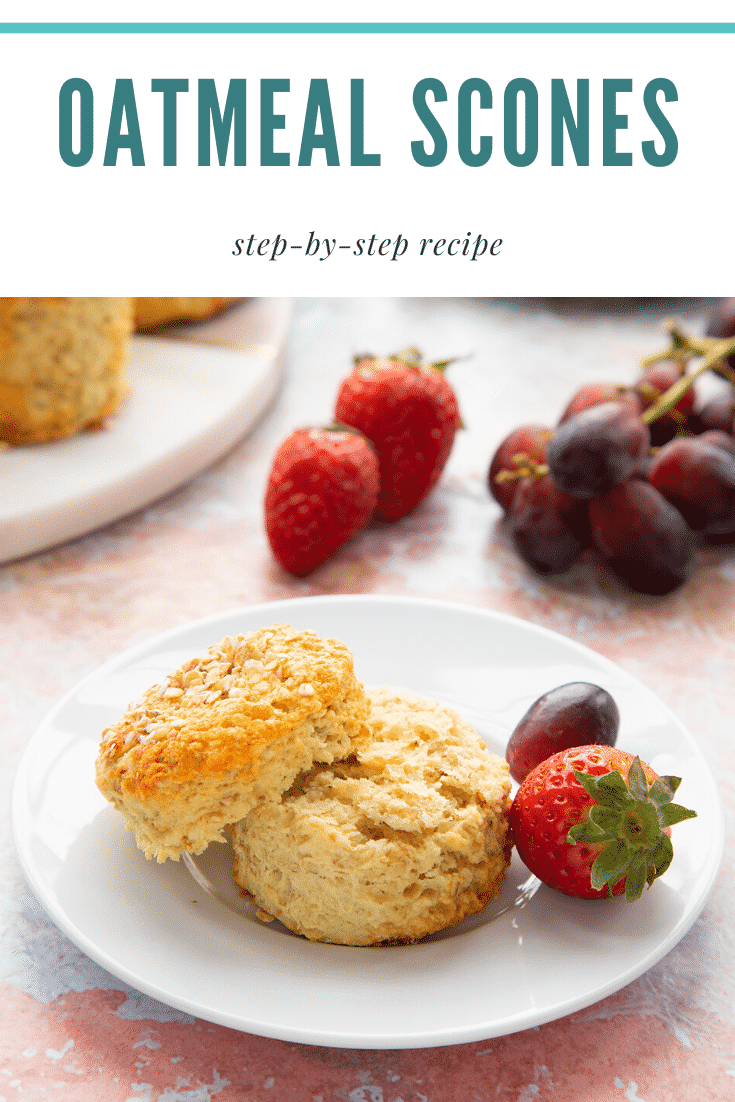
How can I make sure these oatmeal scones are perfectly cooked?
You'll know when the scones are done when they have grown taller, spread out slightly on the tray and turned an inviting golden brown.
Always preheat the oven for perfect scones. They don't take very long to cook so need to go into the oven when it's at the right temperature. Lightly grease your baking trays to stop the scones from sticking, or use a sheet of baking paper.
Try to position the scones in the middle of the oven. This is usually the spot with the most even temperature.
Transfer the scones onto a wire rack to cool.
It's best not to serve scones steaming hot from the oven. This is because, like with standard yeast-leavened bread, the moisture (steam) inside a freshly baked crumb needs time to distribute from the middle and out to the crust. If you cut scones (or slice bread) too quickly, they may seem overly crusty on the outside, undercooked in the middle, and seem to dry out and turn stodgy/stale/gummy as the steam rapidly escapes.
Why did my scones turn out dry and dense?
Scones can turn out dry for a number of reasons. It could be that your ingredient quantities were off, but it's more likely that your scones were cooked at too high a temperature or for too long.
Make sure to set the oven temp carefully and set a timer when the scones go into the oven so they are not baked for too long.
Proper storage will also help combat dry scones. Allow them to completely cool on a wire rack, then transfer to an airtight container. Scones are best enjoyed as fresh as possible. After about two days they will start to noticeably dry out.
Why did my scones turn out dry and dense?
Dense scones are usually a sign that the dough has been overworked.
If your butter is nice and cold, that should help you ensure that your can rub it into the flour mixture without becoming greasy or dense. The process of rubbing in the flour and letting it fall through your fingers also introduces air, which helps lighten the final crumb.
When the milk is added, you need to be very delicate. Any excess handling from this point will result in tough scones.
Using a rounded cutlery knife to cut the milk into the dough is strongly advised. It might seem strange, but it's a great technique because it distributes the ingredients without overworking, compressing or heating the dough with your hands.
Once the dough has started to come together in the bowl, tip it out onto a lightly floured surface and gather together, kneading just enough to get the dough into a rough ball. Don't worry about a few cracks here and there.
Gently flatten the dough ball to about 2.5cm (1 inch) thick using your hands, not a rolling pin as this will compress the dough. Cut the scones out as close together as you can so there is less dough that needs to be gathered and pressed out again to cut the rest out.
Why did my scones turn out wet and undercooked?
Your scones will turn out wet and undercooked if:
- too much milk is added
- you use a margarine with too high a water content
- the oven is too cold
- your scones are not cooked for long enough
- a wet addition is included, such as fresh fruit, which releases moisture into the crumb
Once you've mixed in the milk, if your dough seems really sticky, you've probably added a bit too much. You might be able to rescue it by sifting a little flour on top and then cutting through the mixture. Alternatively, turn out your dough onto a floured surface, and sprinkle a little extra flour over the top before you briefly knead the dough.
Always make sure to wait until the oven has come up to temperature before putting the scones in. Don't be tempted to put them in early thinking this will save time because it won't. If the oven isn't hot enough, the scones won't rise properly or cook all the way through.
Set a timer when the scones go into the oven so you know when to check on them. If, after this time they still don't look cooked return them to the oven for a few extra minutes until they are golden brown.
Why didn’t my scones rise?
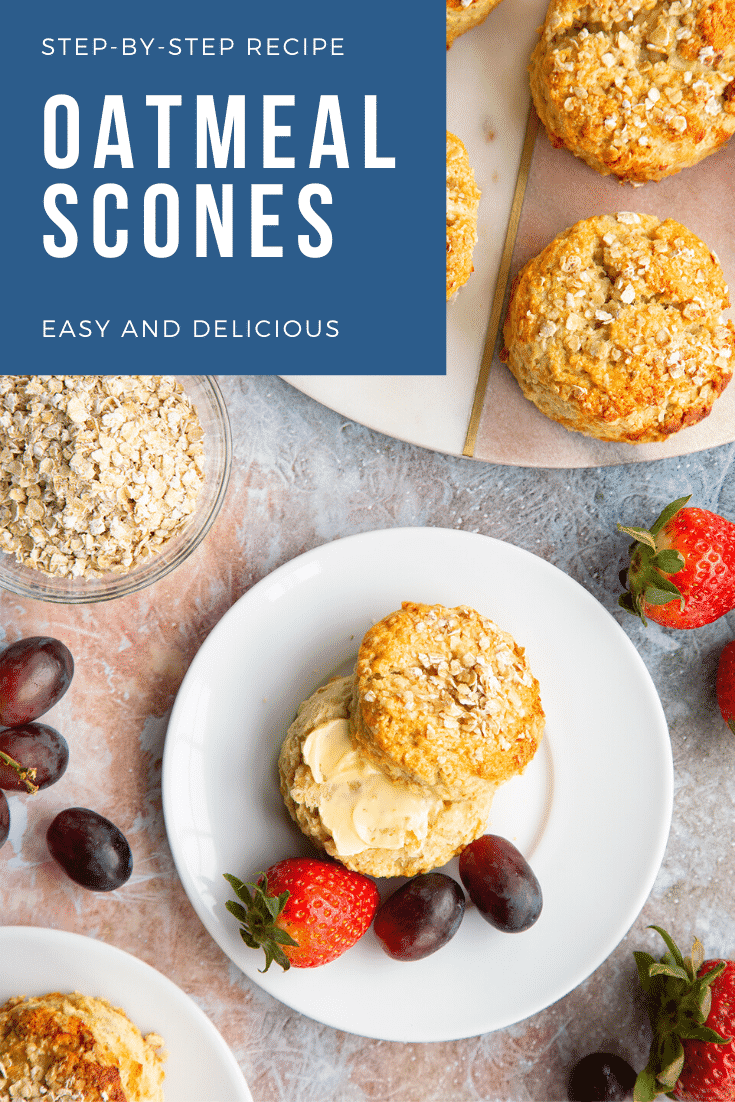
Quite a few things can affect how well scones and other bakes rise.
For this recipe, we're using self-raising flour and adding bicarbonate of soda to work as the raising agents. The raising agents in the flour react together as soon as liquid is added, and the slight acidity in the milk reacts with the added bicarbonate of soda. All this creates carbon dioxide bubbles, and that's what makes the scones rise.
This leavening reaction begins as soon as the dry ingredients are mixed with the milk, which is one of the reasons it's important not to overwork the dough as you will be knocking out any air bubbles already being created.
The speed at which the scones go into the oven is also really important, and is why you should always preheat the oven. If the scones sit out on the side for ages before going into the oven, they will lose some of that reaction before they've had a chance to rise in the oven.
Make sure both your self-raising flour and bicarbonate of soda have been stored in sealed containers are are within their Best Before date as they can become less effective over time.
Another thing that may affect the rise of your scones is the additions. If you have added too much extra fruit, the dough might struggle to rise evenly.
How can I add/change the flavours in this dish?
It's easy to change the flavours in these scones by adding different toppings or even adding dry additions into the mix.
Any dried fruits would work, so use whatever you have to hand. Raisins are a classic, or try chopped dried apricot or figs for something a bit different. Cut any large dried fruits into pieces about the size of raisins, using no more than about 75g (2.6oz) for 12 scones. Add to the dough just after you cut in the milk but before you bring the dough together.
You could also experiment with other dry additions such as nuts or chocolate chips. Avoid wet additions such as fresh fruit as they may make the final scones wet, while the acidity from some fruits could interrupt the rise.
These oatmeal scones are great simply spread with butter and served with fresh fruit. Or you could use them for afternoon tea with clotted cream and jam. They would even be good with a slice of mature cheese.
What is the origin of oatmeal scones?
Scones are a traditional British baked treat often made with flour or oatmeal, so this recipe combines the two.
In the past, they probably would have been baked on the stovetop rather than in the oven, in a similar way to pancakes or Welsh cakes. When baking powder became more widely available and home ovens more reliable, scones were from then on more commonly baked in the oven.
Print this oatmeal scones recipe
Oatmeal Scones Recipe
Ingredients
- 400 g (2⅔ cups) self-raising white flour (self rising flour) plus some for dusting
- 2 tbsp granulated white sugar
- ½ tsp bicarbonate of soda (baking soda)
- 100 g (1 cup + 2 tbsp) oats plus 1 tbsp for the top
- 100 g (7 tbsp) slightly salted butter
- 200 ml (½+⅓ cup) whole milk plus 1-2 tbsp to brush the tops
- 1 tbsp honey
Equipment
- Large nonstick baking tray
Instructions
- Preheat the oven to 200C/390F (180C/355F fan).
- Put the flour, sugar and bicarbonate of soda in a bowl and whisk together to get evenly distributed.
- Add the oats and whisk again.
- Add the butter. Rub together until you have an even crumb.
- Add the milk and mix with a rounded knife until it clumps.
- Tip onto your countertop. Knead gently into a ball, handling as little as possible - don't worry if there are some cracks.
- Flatten to about 2.5cm (1 inch) thick. Use your hands not a rolling pin so that you don’t compress the dough.
- Cut out 6cm (2.5 inch) rounds. You'll need to gather and reshape the offcuts at least once to use it all up - handle the dough as little as possible in doing so. You should get 10-12 rounds in total, depending on how thickly or thinly you pressed your dough.
- Transfer the dough rounds to a greased baking tray.
- Brush the tops with plant milk, scatter with oats then drizzle with honey.
- Bake for 12-14 minutes until the scones have grown tall, golden and are cooked through.
- Allow to cool before serving.
Video
Notes
Nutrition
Pin these oatmeal scones
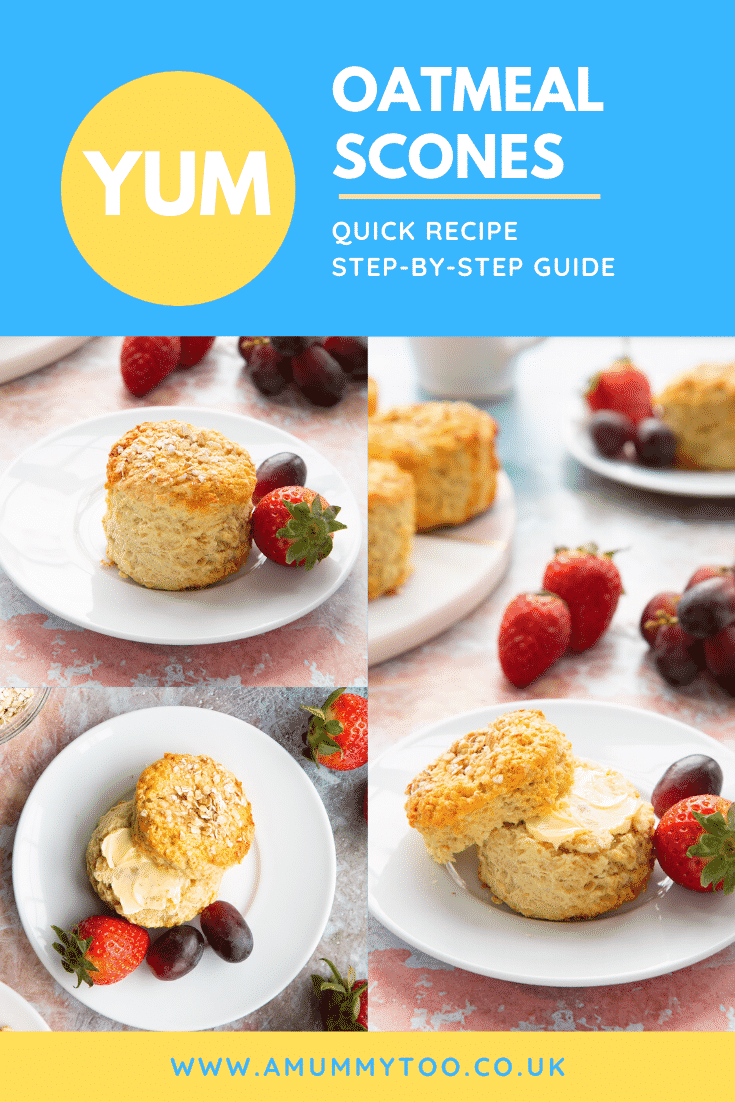
More bread recipes to try
Have you got my book?

'This is a great kids cookery book. Emily is a star' - Simon Rimmer
'The book I'd like to force into any mother's kitchen' - Prue Leith
"A fab book with a plan." - Jane Devonshire, 2016 Masterchef UK winner
'Emily has managed to combine her mummy knowledge and passion for food to make a truly helpful and brilliant cookbook' - Priya Tew, RD, BSc (Hons), Msc
Get Your Kids to Eat Anything is an achievable 'how to' for parents in the battle to overcome picky eating and 'make new the norm'. Emily Leary's unique 5-phase programme looks at the issue of 'fussy eating' in a holistic way that links imagination with food, and which situates parents alongside - not in opposition to - their children.
.


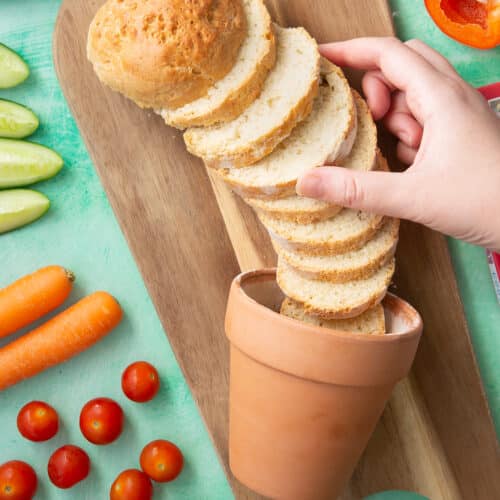
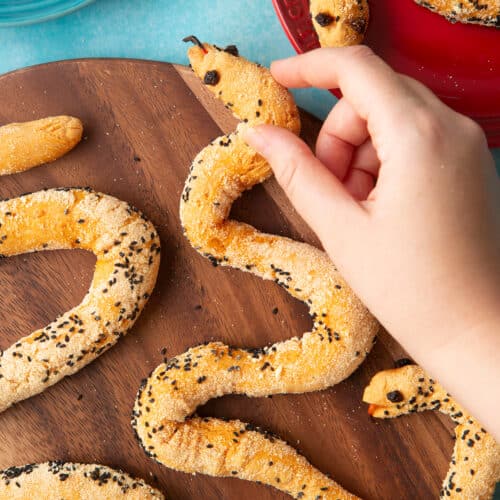
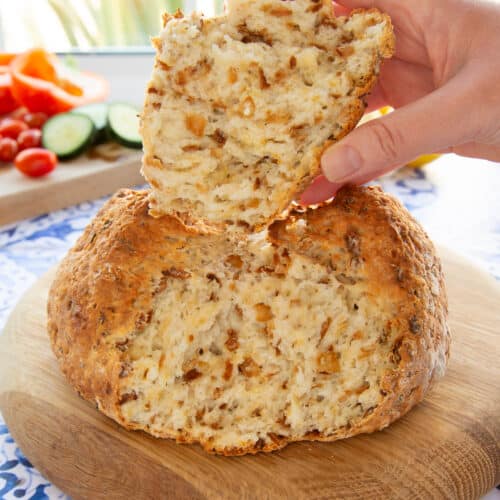

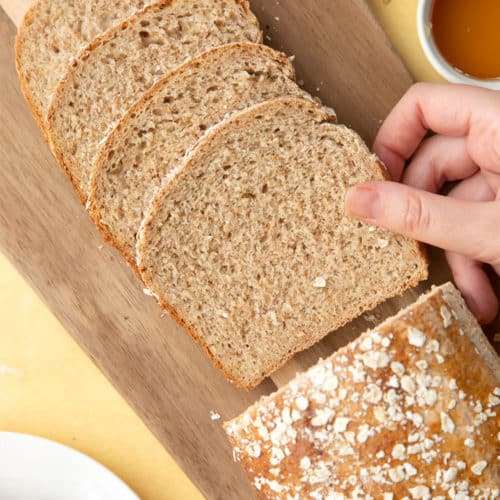
Leave a Reply